Insights
Sustainable Investments: New Markets and Structures for Raising Capital
August 21, 2023
Sustainable managers, particularly those focused on illiquid alternative strategies, often seek out sources of permanent or semi-permanent capital. There are new markets for raising capital and trends in product structure that alternative asset managers may wish to consider. While these opportunities are not always widely known, they are already being utilized by a number of US sustainable managers to raise capital. One is the interval fund market in the US. A second is the London-listed fund market in the UK.
Kimberly Flynn, Managing Director of Alternative Investments at XA Investments, explained, "There are many advantages to both the London-listed fund and US interval fund for sustainable strategies. We spend a lot of time talking to asset managers about the pros and cons of each of these fund structures. A number of funds have launched in the US interval market which invest in sustainable infrastructure, real assets, or impact strategies."
XA Investments recently organized an event hosted by the London Stock Exchange Group (LSEG) at its New York Customer Center on July 25th, 2023, exploring these capital raising pathways for US sustainable managers. In an afternoon marked by extreme, violent storms battering New York - a sign of climate change? - Flynn was joined by panelists who have first-hand experience with these product structures and markets:
- • Wendy Huang, Senior Business Development Manager, Primary Markets Americas at LSEG
- • Kate Moore, Managing Director and Chief Operating Officer at TortoiseEcofin
- • Bob Zimardo, Partner, Investor Relations and Operations at International Farming
Panelists agreed that investor demand for sustainable strategies is growing, and managers are finding new ways to offer these strategies to investors. Yet both a London listing and launching a US interval fund involve nuances and complexities, which managers need to consider, and which require specialized expertise.
The London-listed fund market
The US-listed closed-end fund market is dominated by traditional asset classes and large managers, and IPOs are controlled by a syndicate of four large wirehouse firms. The London Stock Exchange (LSE), in contrast, is "a vibrant and robust market for smaller and middle market companies. We don't directly compete with the NYSE," said Wendy Huang of LSEG. "Companies are able to go public on the LSE at an early stage of growth, typically with lower cost, and under a more flexible regulatory regime."
The investor base differs between the two markets as well, with the investor base for UK closed-end funds being primarily institutional rather than retail, as it is in the US. Pre-IPO test marketing is also permitted in the UK. There are approximately 15 UK broker firms, and the target raise is smaller than that of a US-listed CEF. The appetite for sustainable strategies in the UK is well ahead of that in the US. "Over the last decade, the majority of new listings on the markets have been for alts, and nearly half of these involved sustainable strategies," Huang said. LSEG itself is supportive of sustainable strategies and is spearheading numerous initiatives related to financing the climate transition, including its Green Economy Mark and the creation of the Voluntary Carbon Market.
Kate Moore, COO of TortoiseEcofin, discussed her experience launching two London-listed funds and several US-listed closed-end funds. The manager's sustainable strategies are housed under the Ecofin brand, which is focused on three themes: climate, water, and social impact. Ecofin's first London fund is focused on listed infrastructure, and the more recent 2020-launched fund is focused on middle market, private equity investments in U.S. renewable energy assets. It aims to enable decarbonization efforts required for the energy transition by investing in long-lived renewable assets, such as wind and solar projects.
"When you put alternative and sustainable investments together, it made sense to explore a London listing," said Moore. She found that listing in London was less resource intensive than listing a fund in New York, requiring fewer people and meetings. Test marketing was useful too, providing helpful feedback prior to IPO.
Moore also found that the UK was further along the sustainability journey than the US. Placing private assets in a closed-end fund structure was well understood by the market, upfront expenses were lower in the UK, and growth in assets could take place via follow-on equity raises. And because the London market isn't dominated by a consortium of brokers, "we had more of a say in our destiny in terms of choosing a broker to get to market," Moore said.
TortoiseEcofin maintains a London office. "This is helpful to meet UK institutional demand but is not a requirement," Moore explained. "A lot of investors ask about your commitment level. They want to know your firm is engaged and value facetime with portfolio managers."
International Farming has also been exploring the London-listed fund opportunity. The firm is a specialist real asset manager focused on farmland and agribusiness, based in North Carolina and founded by a seventh-generation farming family. Bob Zimardo, Partner, Investor Relations and Operations at International Farming, said, "Farmland is a nearly $4 trillion industry which is only 1% institutionally owned. Farm families are aging out and the next generation isn't as interested in farming. The opportunity is a massive natural turnover in land. We need the ability to partner with farmers to secure food responsibly for a growing population and do so in a sustainable manner. Our thesis is to bring our expertise to that strategy and provide that opportunity for the investment community."
International Farming already offers private commingled funds but wanted to bring its investment strategies to a broader investment audience, Zimardo said, hence London. "Through conversations with XAI and other market participants we learned there was an opportunity to scale our farmland strategy. We are making an investment on the assumption of being a London market participant for the long term through an eventual IPO."
Listing in London brings with it an entire set of required new partners from brokers to legal to public relations. Zimardo said, "We relied heavily on XAI with respect to selecting the best partners. We spent a lot of time on upfront due diligence when deciding whom we would partner with. Without an advisor we would have had zero chance with our existing resources." (Both International Farming and TortoiseEcofin have used XAI's consulting services.)
The US interval fund market
US interval funds are another promising pathway for sustainable managers to raise capital. The fund structure is well-suited to illiquid strategies which cannot be housed in mutual funds. The investor base tends to consist of RIAs, family offices, and smaller institutions. Investors receive liquidity via a quarterly tender, unlike listed closed-end funds, which are exchange traded.
Flynn noted that not only has the US interval fund market been growing rapidly, but also an increasing number of managers are offering sustainable, alternative strategies using the interval fund structure. "In the interval fund market in the US, the focus has traditionally been on credit or real estate strategies. For the first time, we are seeing a focus on sustainable or impact strategies. This is a growing market."
Moore explained some of the differences from a manager's perspective between US interval funds and listed funds. "Seed capital is always important, but even more so in an interval fund. The interval fund involves more operational complexities, the prospectus is more involved, and it requires an independent board."
With the US-listed closed-end fund market largely closed for new IPOs, it may benefit sustainable managers to consider the interval fund pathway to raising permanent capital.
Decisions... decisions...
The New York and London IPO markets are driven by capital markets and will periodically close. In contrast, the interval fund market is always open. Flynn says, "It takes 6-9 months to launch a listed IPO and you have to plan ahead. You have to get it ready and wait for the right moment, whereas the interval fund market is evergreen in nature."
Listing in London or launching a US interval fund are often unfamiliar pathways for US managers attempting to raise capital. The regulatory, product and market knowledge required is immense. It is therefore important that managers partner with a firm who has expertise in each market and who can further advise on the best structure for a specific strategy.
XA Investments, through its registered closed-end fund structuring and consulting practice, serves clients in engagements ranging from full product builds to marketing services. XAI provides full product launch services, including management of the fund development, regulatory and board approval, distribution planning and offering timetable. XAI has expertise in registered closed-end funds including U.S.-listed CEFs, interval funds, tender offer funds and London-listed funds.
Disclaimer
The information in this publication is provided as a summary of complicated topics for informational and educational purposes and does not constitute legal, tax, investment or other professional advice on any subject matter. Further, the information is not all-inclusive and should not be relied upon as such.
Illiquid investments are designed for long-term investors who can accept the special risks associated with such investments. Interval and tender offer closed-end funds are not intended to be used as trading vehicles. Unlike open-end mutual funds, which generally permit redemptions on a daily basis, interval and tender offer closed-end fund shares may not be redeemable at the time or in the amount an investor desires. Listed closed-end funds frequently trade at a discount to the fund's net asset value. All investments involve risks, including loss of principal. Investors considering an allocation to alternatives should evaluate the associated risks, including greater complexity and higher fees relative to traditional investments. Investors should carefully weigh the diversification benefits, expected returns and volatility of alternatives relative to traditional investments. Investments in alternatives involve risks, including loss of principal. Performance data quoted represents past performance. Past performance does not guarantee future results. Current performance may be lower or higher than performance data quoted. Diversification does not eliminate the risk of experiencing investment losses. You should not use this publication as a substitute for your own judgment, and you should consult professional advisors before making any investment decisions.
This publication may contain "forward looking" information that is not purely historical in nature, including projections, forecasts, estimates of market returns, and proposed portfolio compositions. There is no guarantee that any forecasts will come to pass. This information does not constitute a solicitation of an offer to sell and buy any specific security offering. Such an offering is made by the applicable prospectus only. A prospectus should be read carefully by an investor before investing. Investors are advised to consider investment objectives, risks, charges and expenses carefully before investing. Financial advisors should determine if the risks associated with an investment are consistent with their client's investment objectives.
Launching an Interval Fund Through a Private-Label Provider Can Save Time and Drive Efficiencies
May 31, 2023 | Interview by David Adler
Launching an interval fund is far from easy, and the list of challenges can seem long and forbidding. At the same time, the opportunities are enormous. Given the recent surge in demand for alternative investment strategies, there has never been a more advantageous time to launch an interval fund. Consulting firms, on a private-label basis, can offer asset managers custom product design and strategic advice on various capital raising pathways.
To learn more, I spoke to leading interval fund expert Kimberly Flynn, CFA. Kim has over 20 years of experience in product development exclusively focused on registered closed-end funds ("CEFs"), including listed CEFs, interval funds and tender offer funds. Kim leads the Alternative Investments team at Chicago-based asset manager and private-label CEF provider XA Investments LLC ("XAI"). Kim's experience in launching (as well as managing, merging and closing) CEFs led to the formation of XAI in 2016. Since then, XAI has launched a propriety CEF and helped numerous clients launch their own funds. XAI offers consulting services to help asset managers launch their own proprietary funds and get to market quickly and effectively. XAI also partners with firms that wish to serve as sub-adviser and partner to enter the interval fund marketplace.
Q: How does a private-label partnership with XAI work, and what advantages does it offer to an asset manager that is interested in launching an interval fund?
A: XAI offers a turnkey, private-label CEF platform where we develop different types of CEFs including interval funds, tender offer funds and listed CEFs. We handle all activities related to the custom design, product development and launch of unique and differentiated CEFs for our clients. This includes all of the required regulatory elements such as the registration filings and the requisite operational set-up to manage a 1940 Act registered fund. We also coordinate the product build timetable, work with legal counsel to oversee production of the fund prospectus, assist with assessment and selection of fund service providers, provide setup and guidance on operational matters including valuation policies, liquidity management and portfolio management functions including leverage, building a custom website for each fund, and product positioning and full marketing services offering to ensure a successful launch. We can handle every single aspect of the interval fund launch process through our experienced team of interval fund industry experts.
On the XAI platform, we work with clients of all sizes and with a variety of alternative strategies. We have clients who are boutique alternative investment managers with small teams who are interested in accessing the retail and private wealth markets and other clients are some of the world's largest traditional asset managers who want to enter the interval fund marketplace. We also work with RIAs who are seeking to launch their own proprietary funds.
While our clients hire XAI for a variety of reasons, they all benefit from the advice we provide to de-risk the launch of a new fund. Some of our clients have full product management or product development teams in-house but are bandwidth constrained with multiple high priority initiatives and struggle to make time for a new interval fund launch. Other clients, especially alternative investment managers, have streamlined organizations, and the in-house business development team does not have staff or experience launching interval funds. XAI aligns with our clients for success and we serve as an extension of our client's investment and product teams. With our rich experience working on many different CEF builds over the years, we are able to transfer interval fund product and market knowledge to our clients during the product development process. XAI works behind the scenes to make sure the project manager at our client is recognized for the project success.
Q: Does XAI provide feedback on whether a prospective client's idea for an interval fund is feasible or even viable?
A: Yes – we typically start each client engagement with a detailed feasibility study which involves four to eight weeks of workshops around the investment strategy and its fit in the interval fund structure. We focus in on the economics of the interval fund and make sure that clients understand what it takes to break-even and to scale a new fund. We also analyze our client's firm capabilities and readiness as it relates to managing a registered fund. We want our clients to be successful, and the feasibility study helps our clients align thinking around the details of the proposed fund prior to beginning the full-scale private-label fund build. We assist with expediting internal decision making and providing additional context for such decisions. Our clients often need to take the findings of the feasibility study back to their internal constituents and work to seek approval to take next steps on the project. The feasibility study helps provide the evidence to support the market opportunity and specifically the product opportunity that the firm intends to pursue.
Q: How does XAI guide a client that has already selected an investment strategy and is committed to launching an interval fund?
A: We advise clients that have already chosen to move forward with an interval fund on the optimal product structure given their strategy and objectives. For example, many clients want to understand the benefits and trade-offs with launching a fund in the interval vs tender offer fund structure. With tender offer funds, the fund board has the ability to stop or vary the amount or number of tenders which may be useful in volatile markets for certain illiquid alternatives. We also know the history of the interval fund marketplace and can analyze the competitive landscape to help identify gaps in the market that need to be filled and ways to differentiate the new fund.
Q: How long does it take to launch an interval fund?
A: For the average interval fund, it can take eight to twelve months from start to finish to launch. Recently, both the SEC registration process and the wait time for interval funds to be added to clearing firm platforms have lengthened, making timetable management and sequencing concurrent processes even more critical.
While speed to market is important for some clients who want a first mover advantage, other clients are more concerned with avoiding missteps or are more focused on medium-term milestones like reaching the $100mm or the $500mm AUM mark. XAI is able to help clients achieve their various objectives. Our interval fund platform creates efficiencies in the process that are not otherwise possible. XAI clients achieve a successful fund launch by keeping all bodies of work moving simultaneously. We help facilitate cross-functional working group activities and make sure external service providers are aligned for an on-time fund launch. Like all projects, an interval fund launch tends to uncover numerous sticking points and unforeseen challenges along the way—we focus on highlighting the common sticking points that come up in a fund launch and work with constituents to find the right solution ahead of time.
Q: Why is a private-label partnership so valuable when launching interval funds, specifically?
A: Interval funds are unique in that their N-2 filing or SEC registration does not reflect their practical starting point; reaching $100 million in AUM is the de facto beginning of an interval fund's life. However, raising $100 million from $0 can be incredibly difficult and requires detailed sales and distribution planning or seed capital. XAI assists clients with their go-to-market plan including sales, marketing, and national accounts planning. In addition to the SEC registration process and distribution planning, firms launching a new interval fund must also manage a fund board review and approval process. XAI has experience managing these concurrent workstreams and ensuring that nothing is overlooked.
Q: How can XAI help new/emerging managers or managers wanting to launch their first CEF?
A: XAI handles complex investment strategies and enjoys working with clients who are trying to do something that is new or different (e.g., a new asset class or new fund structure). In launching interval funds, much of the complexity of a fund launch lies below the surface. XAI dives deep into problem solving and addressing issues that arise through our proprietary interval fund product development process.
XAI can also open doors for fund sponsors when entering a new market. We understand the challenges of launching new initiatives—after all, we're a fund management firm too. Prior to launch, XAI works with its consulting clients on strategies to raise seed capital or contribute a private fund to help scale a new interval fund. XAI served as a consultant to Thornburg on the launch of its debut listed CEF offering in July 2021 – the $640mm Thornburg Income Builder Opportunities Fund (Nasdaq: TBLD). XAI also manages the $400mm XAI Octagon Floating Rate & Alternative Income Term Trust (NYSE: XFLT) which launched in September 2017. Thornburg and XAI were two of only three new listed CEF sponsors to enter the market in the past eight years.
Q: Where have you seen innovation in the interval fund market recently?
A: The Hamilton Lane interval fund recently filed for a digital share class, introducing blockchain technology into the interval fund space. XAI anticipates that blockchain technology can transform the operational aspects of registered fund industry and expects the tokenization of funds and the addition of blockchain-native share classes to become more prevalent in the near future. A digital share class can help an interval fund sponsor streamline the issuance process and reduce some inefficiencies and expenses. More alternative asset managers are expected to commit to utilizing such technology to broaden investor access to the private markets. XAI will be working with industry participants and asset managers to help implement blockchain technology across the interval fund marketplace.
Q: Are there any interval fund trends you expect will do particularly well going forward?
A: There is still plenty of room for product category expansion in the sustainable investing space, where we've observed tremendous growth in the last 10 years in the UK market. Sustainable investing themed funds in the London-listed fund market have had success raising capital across different asset classes including venture capital, private equity, private credit, farmland and infrastructure. In the US interval fund market, these areas of investment are all underrepresented. Infrastructure and real assets make up a relatively small portion of the assets in the interval fund market. In the US interval fund market today, we observe four sustainable focused or impact-oriented funds, but we anticipate more to follow. The fund-of-funds space will continue to grow as well as more asset allocators and institutional investment consultants sub-advising and launching proprietary funds.
Another interesting trend is that of new types of funds sponsors entering the interval fund market. We observe an increasing number of FinTech direct-to-consumer platforms that have launched proprietary funds – many of these funds are fund-of-fund strategies. We also note that RIAs with large pools of discretionary assets under management have launched proprietary interval funds. We help RIAs with product structuring and help these wealth managers identify ways to expand interval fund distribution beyond their initial client audience.
Q: Do you expect continued growth in the private-label interval fund trend?
A: We feel this is just the beginning of the private-label approach to launching interval funds. XAI is the only independent consulting firm in the market today that can guide clients from start to finish through the interval fund product development process and provides hands-on product launch execution services. The XAI platform gives new issuers the highest probability of success when launching their own proprietary funds. As more firms begin working with us in the interval fund marketplace, awareness of what we are able to do for our clients will increase. We are often approached by asset managers that indicate they plan to launch an interval fund and we help them evaluate capital raising pathways that might be best-suited to their goals and preferences.
Q: What are the global opportunities in launching interval funds?
A: Demand for interval funds and similar semi-liquid alternative fund structures is exploding globally, with a huge amount of activity taking place in Europe. We feel managers should not limit their launch and growth plans to the US, while other markets can be a better fit for specific strategies.
We have extensive consulting experience in the London market and deep knowledge of local players, ranging from brokers to media to institutional partners. Recently, we have advised prospective and current clients who are considering launching interval funds in the United States on steps towards also launching a London-listed fund in the United Kingdom or even to contemplate the updated Luxembourg evergreen fund structure which shares similarities with the interval fund.
Q: Any final thoughts?
A: Clients should not be deterred from launching an interval fund, but they should be realistic. Having the right partner and launch strategy is key. XAI can advise on the best structure for a particular investment strategy, conduct a feasibility study and, ultimately, act as an extension to the client's team throughout the fund build and launch. By working with XAI, asset managers can accelerate both decision making and the entire launch process.
About David Adler: David is an economic analyst and author. His work focuses on illiquidity and behavioral economics. For XAI, David has written several white papers, including "Invest Like the Pros: Using Liquidity Premiums to Drive Portfolio Outcomes," "Overcoming the 'Liquidity Mismatch' in Individual Investor Portfolios" and "Using Alternatives to Achieve Your Retirement Goals." For the CFA Institute Research Foundation, David wrote "The New Economics of Liquidity and Financial Frictions." David has an MA and BA in economics from Columbia University. He serves as a Senior Advisor to XAI.
About Kimberly Flynn: Kim is a Managing Director at XAI with a wide range of product structuring expertise. She is a partner in the firm and responsible for all product and business development activities. Kim is a frequent contributor to media and industry events on topics including interval funds, alternative investments and London-listed investment companies. Kim has an MBA degree from Harvard University and a BBA in Finance and Business Economics, summa cum laude, from the University of Notre Dame. Kim earned the CFA designation and is a member of the CFA Institute and CFA Society Chicago.
Disclaimer
The information in this publication is provided as a summary of complicated topics for informational and educational purposes and does not constitute legal, tax, investment or other professional advice on any subject matter. Further, the information is not all-inclusive and should not be relied upon as such.
Illiquid investments are designed for long-term investors who can accept the special risks associated with such investments. Interval and tender offer closed-end funds are not intended to be used as trading vehicles. Unlike open-end mutual funds, which generally permit redemptions on a daily basis, interval and tender offer closed-end fund shares may not be redeemable at the time or in the amount an investor desires. Listed closed-end funds frequently trade at a discount to the fund's net asset value. All investments involve risks, including loss of principal. Investors considering an allocation to alternatives should evaluate the associated risks, including greater complexity and higher fees relative to traditional investments. Investors should carefully weigh the diversification benefits, expected returns and volatility of alternatives relative to traditional investments. Investments in alternatives involve risks, including loss of principal. Performance data quoted represents past performance. Past performance does not guarantee future results. Current performance may be lower or higher than performance data quoted. Diversification does not eliminate the risk of experiencing investment losses. You should not use this publication as a substitute for your own judgment, and you should consult professional advisors before making any investment decisions.
This publication may contain "forward looking" information that is not purely historical in nature, including projections, forecasts, estimates of market returns, and proposed portfolio compositions. There is no guarantee that any forecasts will come to pass. This information does not constitute a solicitation of an offer to sell and buy any specific security offering. Such an offering is made by the applicable prospectus only. A prospectus should be read carefully by an investor before investing. Investors are advised to consider investment objectives, risks, charges and expenses carefully before investing. Financial advisors should determine if the risks associated with an investment are consistent with their client's investment objectives.
The Rise of Alternatives and the New 60/40 Portfolio
May 03, 2023 | David Adler
The 60/40 portfolio—60% equity, 40% bonds—historically was the standard model for asset allocation. The intuition underlying this portfolio strategy is one of diversification: when equities fall, the bond portion of the portfolio provides stability, offsetting the equity decline. The 60/40 model has long been unquestioned as a dependable way to achieve stable returns. Market shifts in 2022 changed that thinking.
In 2022, both equities and bonds declined significantly: -19.44% for equity (S&P 500 Index) and -13.01% for bonds (BBG Barclays US Aggregate Bond Index). In simplest terms, the 60/40 portfolio stopped working, and investors experienced large drawdowns. Investors were left to wonder why traditional portfolio diversification failed and how they could better protect their portfolios in the future.
To help address these questions, XA Investments organized an expert panel discussion on February 15, 2023 at the New York Stock Exchange to re-examine the 60/40 portfolio and identify better strategies for asset allocation going forward. The panelists shared their broad range of perspectives:
- • Brian Chiappinelli, Managing Director, Cambridge Associates
- • Michael O'Malley, Real Estate Professor, University of Notre Dame
- • Nathan Shetty, Head of Multi-Asset, Nuveen
- • Moderator: Kimberly Flynn, Managing Director, Alternative Investments, XA Investments
The overwhelming consensus of the panel was that a 60/40 portfolio could still be successful, but the definition of "equity and bonds" needed to be expanded to include alternative investments to help achieve improved diversification and higher potential returns and downside protection.
Panel moderator Kim Flynn of XAI said, "With the negative performance of both stocks and bonds in 2022, many investors are considering using alternatives to replace traditional investment exposures. For example, investors might replace trading from fixed income allocations to high yield bonds with an alternative income option that might offer higher yields, diversification potential, and less duration risk."
A related theme of the event was to highlight recent advances in product design which allow investors to implement the "new 60/40." Alternatives are now more accessible than ever to a broad range of investors, leading to a potential revival of a 60/40 allocation, albeit one redefined to include more alternative asset classes.
While the traditional 60/40 has bounced back somewhat in Q1 2023, the experience of 2022 and the need for increased diversification within the portfolio remain at the forefront of investors' and managers' minds. The BlackRock Investment Institute recently issued a report on April 17, 2023 warning, "We don't see the return of a joint stock-bond bull market. We think strategic allocations of five years and beyond built on these old assumptions do not reflect the new regime we're in."
New Asset Classes
Flynn also pointed out that individual investors tend to be highly reliant upon the traditional 60/40 portfolio, despite its limitations. Nuveen's Nathan Shetty, who pronounced 2022 a "bloodbath for 60/40," drilled more deeply into some of the traditional allocation's inadequacies.
"60/40 is an arbitrary stock/bond split; it doesn't consider the intra-asset class composition, objectives, constraints, or risk tolerances and most importantly it doesn't reflect changing risk, return and correlation," he said.
Shetty argued for the need for an expanded asset class mix for investors, particularly in fixed income: "Going forward, I don't see bonds being the unicorn asset they were over the last 40 years. Correlations are likely to be positive with equities. We need to seek ballast elsewhere - cash, real assets, commodities, and long vol/trend following strategies seem like compelling alternatives."
Shetty also pointed to the attractiveness of private credit, both for ballast and as a source of income. "Private credit is particularly relevant to the recent economic backdrop. These are typically floating rate structures and so could participate in rising rates," Shetty said.
Though Shetty himself avoids the 60/40 framework, instead taking a more granular approach focused on factors and geography, many other conference participants found immense value in the simplicity of the 60/40 allocation, but one now redefined to include alternative investments.
"Today's tools are more sophisticated than when 60/40 was devised," said Brian Chiappinelli of Cambridge Associates. "The 60/40 split hasn't changed but the exposure to alts will increase relative to history."
Real estate may also fit into the new 60/40 portfolio. "It is the largest asset class in the world, and is a meaningful part of a diversified portfolio as it has the ability to provide depreciation-shielded current income with long-term appreciation," said Michael O'Malley of Notre Dame in his presentation. He further noted that real estate itself is a highly variegated asset class. Today's investors also have new choices in how to access real estate. "Sophisticated investors have the ability to build real estate portfolios through direct investments, private funds, and publicly-traded and private REITs," O'Malley said.
Increased Access to Alts Drives New Portfolio Construction
A consistent theme of the conference was that this new, more diversified 60/40 is now available to individual investors. "Modern advancements in product design make these allocation decisions easier and allow individual investors to access a broader set of alternative investment options," Flynn said.
This increased accessibility of alternative investments stems from three drivers, according to Chiappinelli:
- • Regulatory regime updates: "The SEC guidelines changed, expanding the definition of an accredited investor [thereby increasing the universe of those who can invest in alts]," he said.
- • Financial management trends: "There is increased understanding by financial managers of how to explore alternatives within a vehicle," Chiappinelli said.
- • Improved vehicles: Here Chiappinelli pointed to the explosion in the number of structures that hold alts, including both listed and non-listed closed-end funds, such as interval funds, and collective investment trusts (CITs).
Not only is access to alternatives more viable than it was in the past, but alternative investments are also more prominent, leading to increased demand from individual investors. "Ten years ago, nobody talked about private investments. Now, social influencers have exposed investors to venture capital [and the like]," Chiappinelli said.
Much of alternatives' higher historical returns derive from an illiquidity premium. This brings a new dimension - and potential caveat - to constructing a portfolio using these new vehicles. Interval funds offer only partial liquidity (typically via quarterly share repurchases), which can be particularly noticeable during a crisis. Allocators need to be aware of this potential for illiquidity, Chiappinelli said, regardless of how the product is sold. Nonetheless, he said, "Cambridge Associates has been a strong advocate for alternatives. We have seen this on the institutional side and now the retail side."
And there is another fund structure which offers liquidity in a traded form, namely publicly listed closed-end funds. Kim Flynn closed the conference at New York Stock Exchange pointing to the elegance of this vehicle in its ability to hold illiquid alternative investments while offering liquidity by trading on an exchange.
Disclaimer
The information in this publication is provided as a summary of complicated topics for informational and educational purposes and does not constitute legal, tax, investment or other professional advice on any subject matter. Further, the information is not all-inclusive and should not be relied upon as such.
Illiquid investments are designed for long-term investors who can accept the special risks associated with such investments. Interval and tender offer closed-end funds are not intended to be used as trading vehicles. Unlike open-end mutual funds, which generally permit redemptions on a daily basis, interval and tender offer closed-end fund shares may not be redeemable at the time or in the amount an investor desires. Listed closed-end funds frequently trade at a discount to the fund's net asset value. All investments involve risks, including loss of principal. Investors considering an allocation to alternatives should evaluate the associated risks, including greater complexity and higher fees relative to traditional investments. Investors should carefully weigh the diversification benefits, expected returns and volatility of alternatives relative to traditional investments. Investments in alternatives involve risks, including loss of principal. Performance data quoted represents past performance. Past performance does not guarantee future results. Current performance may be lower or higher than performance data quoted. Diversification does not eliminate the risk of experiencing investment losses. You should not use this publication as a substitute for your own judgment, and you should consult professional advisors before making any investment decisions.
This publication may contain "forward looking" information that is not purely historical in nature, including projections, forecasts, estimates of market returns, and proposed portfolio compositions. There is no guarantee that any forecasts will come to pass. This information does not constitute a solicitation of an offer to sell and buy any specific security offering. Such an offering is made by the applicable prospectus only. A prospectus should be read carefully by an investor before investing. Investors are advised to consider investment objectives, risks, charges and expenses carefully before investing. Financial advisors should determine if the risks associated with an investment are consistent with their client's investment objectives.
Interval Fund Governance Considerations
March 22, 2023 | XA Investments LLC
Role of the Interval Fund Board
All interval funds must be governed by a fund board of directors. Like a corporate board of directors, the board of an interval fund registered under the Investment Company Act of 1940 (the "1940 Act") has a fiduciary duty to represent the interests of the fund's shareholders. The operations of the fund, however, are clearly different than those of a corporation. With very few exceptions, 1940 Act registered interval funds have no employees. As such, the fund board relies on various service providers to manage the fund's operations. The primary service provider is the fund's investment adviser. Additional key service providers include fund administrator and accountant (often the same firm), the fund's chief compliance officer, and the fund's independent auditor. As a fiduciary, the fund board should continually assess the performance of the fund's service providers, their respective fee arrangements, and the conflicts of interest that each service provider may have with the fund and its shareholders.
In practice, all registered funds likely have at least one service provider with an inherent conflict - most commonly, the adviser. Due to advisory fees being charged on either net assets or managed assets, the adviser may be incentivized to take risks it would not normally consider. The fund board should consider the potential mitigating factors and the level of conflict it deems acceptable given the fund's structure and goals.
Fund Board Activity Level
The fund board's chief role is to provide oversight for the fund and its shareholders - not to be involved in the fund's day-to-day management. Even still, the fund board oversees the management and operations of the fund, as the ultimate decision-maker on behalf of shareholders. This means that, depending on a fund's investment strategy and structure, the fund board could meet along with the fund's key service providers only once per quarter, or it may need to meet more often. Generally, most registered fund boards have four quarterly meetings with the investment adviser, CCO, administrator and accountant, along with perhaps two additional meetings during the year for "special" or non-regular matters.
Directors oversee the performance of the fund, the agreement with and fees paid to the adviser for its services, conflicts of interest, and the fund's compliance program, among other things.
Portfolio Management and Fund Operations
It is not the fund board's role or responsibility to make portfolio management decisions or make recommended investments for the fund or its adviser. The fund board delegates operational responsibility to the fund's officers. The fund's officers oversee the day-to-day operations of the service providers. Officers typically include a President or CEO, Treasurer and CFO, Secretary and/or Chief Legal Officer, CCO, and various assistants to the roles.
1940 Act and Fund Board Independence
The 1940 Act prescribes certain requirements for fund board independence. The 1940 Act requires that at least 40% of directors be "independent" and strictly defines independence. In reality, nearly all registered fund boards are predominantly independent, as various necessary fund board approvals would not be reasonably feasible without a larger number of independent directors.
What qualifies a director as "independent"? For one, they cannot own equity or stock of the investment adviser (or any sub-adviser) or their parent companies, subsidiaries, etc. Additionally, an independent director should not have currently or during the previous two years a significant business relationship with the fund's adviser (including sub-advisers), distributor/underwriter, or their affiliates. A classic example is employment or consulting arrangements - the former is clear, while the latter is subject to counsel review and likely a facts and circumstances test (and to be safe, most counsel would likely find any direct consulting relationship to taint the independence).
A director who is not independent is considered an "interested person" under the 1940 Act. All funds should at least annually consult with their directors (most use an annual questionnaire) to determine whether any independence issues exist.
Key Members on an Interval Fund Board
A fund board will typically have four or five total members, with three to four of those members considered independent. Each fund board member may vote on matters (although interested directors may not vote on certain matters). All fund board members have equal votes. With that said, certain fund board members may fill specific roles, including the following:
- • Chairman of the Board
- • Chair of the Audit Committee
- • Chair of the Nominating & Governance Committee
- • Chair of ad hoc or other committees
Fund Board Committees
Most fund boards have established committees that focus on specific subject matters. The most common are the audit committee and nominating & governance committee. Fund board members can expect to provide additional time and effort to their committee assignments. Additionally, fund boards may often establish ad hoc committees for various unique or irregular operational matters such as capital transactions, investigations, etc.
- • Audit Committee. The audit committee typically oversees the accounting and financial review, audit and reporting process, as well as the internal controls over financial reporting. Additionally, the committee will often oversee the fund's principal financial officer and the fund's independent auditor.
- • Nominating & Governance Committee. The nominating & governance committee oversees the fund's process and matters related to fund board membership and fund board efficacy, including annual fund board self-evaluation, compensation reviews and recommendations, searches for new fund board members, and nominations of fund board members.
Fund Board Diversity Recommendation
Fund boards and the asset management industry have become increasingly aware of disparities in shareholder representation on fund boards. For example, a recent industry survey showed that 65% of all independent fund board members for registered funds were men, while 86% of independent fund board members for registered funds identified as white. With that in mind, some fund sponsors and fund boards have adopted policies and procedures to encourage more diverse representation in their fund board searches and nominating processes. With that said, there is currently no obligation in the U.S. for a fund board to adopt such procedures or seek to meet any diversity requirements.
Fund Board Formation Options
Interval fund managers may decide to use an existing mutual fund board or stand up a new fund board. Alternatively, management may wish to save time/money by joining a series trust platform which has a shared fund board.
- A. Recruit Board Member Candidates for New Fund Board
-
1. Candidates recommended by trusted service providers
Typically include candidates with expertise in the asset class, finance/accounting, operations, capital markets, and/or the investment management industry. Interval fund board candidates often have alternatives experience as well. -
2. Manager interviews candidates and makes selections
Pre-screen or evaluate candidates by determined criteria. -
3. Chosen candidates accept and are appointed at the initial board meeting
The fund board members will then oversee the fund for as long as they serve. - B. Join an Existing Series Trust Platform
-
In the mutual fund market, series trusts are commonly used as a way to gain economies of scale for small or new fund managers. While all closed-end funds, including interval funds, require each trust to be a separate legal trust, several fund administrators have created quasi-series trust platforms with shared fund boards and service providers to help reduce costs and speed up the product launch.
Best Practices for Fund Board Formation and Candidate Selection/Election Process
- • Experience. The learning curve can be steep for interval funds which typically house alternative investment strategies. Interval fund boards will need a level of comfort with valuation policies and procedures for less liquid or illiquid assets. Past experience with alternative investments is a key consideration in the candidate selection process.
- • Fit is Important. Group fit among members is important to helping with critical and complex decision making.
- • Audit Committee Chair. It can be difficult to find an audit chair with necessary qualifications, experience and the comfort level to oversee fund audits and the principal financial officer's team. Identify candidates early in the process and determine their ability/desire to serve as an Audit Committee Chair.
- • Trustee Counsel. Speak with the selected fund counsel and ask for recommendations. Trustee counsel and fund counsel must work closely together, so a good working relationship and experience together can be helpful to the trust and also drive fee efficiencies.
- • Candidate Availability. Identify fund board candidates that have time to dedicate to the fund board and that can attend in-person meetings. If candidates are still working full-time, scheduling (and potentially independence conflicts) can be a challenge.
- • Geographic Location of Candidates. Select candidates in the same time zone to ease scheduling of special and ad hoc fund board meetings - this can be especially trust for funds that intend to rely on co-investment relief and have high transaction velocity. The fund boards of such funds are often required to have ad hoc meetings that need to be organized quickly.
- • 1940 Act Experience. Identify candidates (at least one) with prior board service experience on a 1940 Act fund board or a candidate with experience serving as an officer of a 1940 Act fund as an asset manager. Experience with the broader 1940 Act rules and regulations can be very helpful.
- • Prestige Is Not Important. Because the role of the board for a 1940 Act fund is different from an operating company, there's much less (if any) value in having board members that would be seen as prestigious for (e.g., board membership for a Fortune 500 company). Fit and specific experience outlined above are more important than an impressive resume or connections.
Additional Resources for Fund Sponsors and Fund Board Candidates
Disclaimer
The information presented herin is presented in summary form and is, therefore, subject to qualification and further explanation. It is intended for informational purposes only. Further, the information is not all-inclusive and should not be relied upon as such. XA Investments LLC does not warrant the accuracy, timeliness, or completeness of the information herein, and this publication is not offered as advice on any particular matter and must not be treated as a substitute for specific advice. In particular, information in this publication does not constitute legal, tax, regulatory, professional, financial or investment advice and nothing contained herein should be construed as such advice.
Career Insights with Helen Vaughan
March 8, 2023 | Helen Vaughan
For International Women's Day, XA Investments would like to recognize Helen Vaughan. Our team recommended Helen for a board role on an UK investment trust that is under development through our XAI consulting practice. Helen currently serves as non-executive director on three Irish fund boards, an Irish management company, a UK ACD company and a UK investment trust. Previously, Helen was the Chief Operating Officer at the JOHCM Group, Director of Business Development at Credit Suisse, Head of Investment Operations at SLC Asset Management, and Head of Client Accounting at Framlington.
Helen believes surrounding yourself with good people, listening to different perspectives but ultimately taking responsibility for the decisions you make is crucial to success. We are pleased to share some of her insights and offer others the opportunity to learn from her.
What is your most valued skill or personality trait that has helped drive your career success?
I was very fortunate to be brought up in a loving and nurturing family. My parents gave me the inner self confidence to pursue what I think is right (a trait I share with my father). In addition to having confidence in my decisions, I think that one of my most valuable personality traits is being pragmatic. I have also been very fortunate with respect to the people who have worked for me - I do not think you can succeed without surrounding yourself with good people and listening to different perspectives. That being said, you must ultimately take responsibility for the decisions you make.
Why did you pursue various non-executive director (NED) roles and how do you think you were best prepared to take on that type of governance role?
After nearly 30 years as an executive in investment management, I took the opportunity to retire from my executive life, move to West Wales and rebalance my life. This involved taking care of my two elderly parents and reassessing my priorities. I am a doer and needed to maintain work engagement, which I was able to do through my NED roles. Prior to retiring as an executive, I qualified as a Certified Investment Fund Director, so the transition from executive to a governance role was fairly seamless. Since then, I have continued to add to my portfolio of NED roles.
Recommendations for resources for women looking to advance their careers?
When I started work in the 1980s, things were very different. The large accountancy firm I trained with did not even have one female partner at that time! Things have progressed in leaps and bounds, and there are now many more opportunities for women and groups which can help women advance their careers. Women in Asset Servicing, Women in Investment, the Diversity Project and many other groups all help in providing opportunities for career progression. However, there is no real substitute for finding a strong mentor within your work organization to help you progress.
10 Lessons Learned in Launching Interval and Tender Offer Funds (Non-listed CEFs)
February 6, 2022
- Start the Process with Sales
The sales, distribution, national accounts and marketing strategy is often overlooked or discounted by investment strategy-led firms. Many first-time fund sponsors begin drafting the N-2 prospectus before working through the various sales and marketing considerations, which can impact the terms and structure of the fund. It is important to first consider what retail or end investors want and what changes need to be made to the investment strategy to avoid unnecessary amendments and re-work after launch. - Don't Chase the Market Leader
The non-listed CEF market has tremendous growth potential as retail demand for access to alternatives increases and as more advisors and investors adopt the use of the non-listed CEF structure. There are several alternative asset managers currently leading the non-listed CEF market by assets in the credit and real estate segments. There are also several well-established traditional asset management firms that have launched multiple non-listed CEFs with the support of their large mutual fund sales teams. New fund sponsors should not be concerned with chasing these players. Alternative investment managers can be successful with a small sales team that has strong relationships with RIAs or family offices. Focus on existing institutional client relationships - clients that know and trust the firm. - New and Different is Good, but
Challenging
The SEC registration process can be elongated by multiple rounds of comments and edits required on new or nuanced fund structures. Experienced product design and legal teams can assist with keeping this process as smooth and quick as possible. Find legal counsel, auditors or consultants that have specific experience with non-listed CEFs. - Product Design Matters
Alternative asset managers with primarily private funds lack familiarity with registered funds and may not have an appreciation for the nuances of the 1940 Act, including reporting requirements and legal limitations. Product design drives the ability to sell the fund and allows the fund to be competitive in the marketplace. Many non-listed CEFs with good portfolio performance have been closed or failed to scale and gain critical mass, which can result from the product structure being treated as an afterthought. - Clones Not Welcome Here
Non-listed CEFs are designed to house illiquid investments. If an investment strategy fits in the mutual fund, UCITs or ETF structure, it is likely not a good fit for the non-listed CEF structure. The SEC staff will question any non-listed CEF that has a large allocation to liquid securities and may challenge the structural fit. As such, clone funds or variations on liquid investment strategies are not likely to work in a non-listed CEF. Fund sponsors should consider evaluating existing private fund strategies to see if any of those institutional alternatives can be offered to retail investors using the non-listed CEF structure. - Get in Line with Clearing Firms
Early
Adding a new non-listed CEF to a major custody platform like Schwab, Fidelity or Pershing can take upwards of 3 to 6 months. There is a queue, it is typically first come, first served and gathering indications of interest ahead of onboarding is important. If the fund is complex or the sponsor is slow to address diligence questions, the onboarding process will likely be stalled. - Liquidity, Liquidity, Liquidity
Liquidity is a crucial topic for both managing and marketing non-listed CEFs. Non-listed CEFs typically hold illiquid assets and require advanced liquidity planning to be prepared to meet quarterly redemption requests. Fund managers must think long and hard about their liquidity management plan and ensure they are prepared to withstand multiple quarters of full redemptions. When marketing non-listed CEFs, sponsors should properly convey to investors that the investment should be long-term, they will have limited liquidity at exit, and their redemption request may be prorated. If framed properly, the lack of liquidity can be a selling point when educating investors on the benefits of a non-listed CEF, as it can help prevent the realization of temporary losses. - Daily NAV Opens Doors
Non-listed CEFs that generate a daily NAV strike are permitted to join the NSCC/FundSERV mutual fund ticketing platform, which can significantly impact a fund's ability to gain sales traction. Non-listed CEFs with a less frequent NAV calculations must use subscription documents for new investments into the fund. An increasing amount of non-listed CEF sponsors with largely illiquid investment portfolios have developed policies and procedures to arrive at daily valuations by working with experienced fund administrators and 3rd party valuation agents. - Avoid the Valley of Death
The registration of a non-listed CEF with the SEC is not its starting point; the practical launch is when it reaches $100 million in AUM. By kickstarting the launch of a fund with seed capital, lead capital or contributed capital (e.g., private fund conversion), managers help de-risk the launch of their fund. No new investor wants to be the first investor into a small, sub-scale fund. Very few third-party sales teams effectively raise capital in non-listed CEFs because the initial sale from dollar zero is so challenging. Starting out of the gate with $50mm or $75mm accelerates the capital raising process with RIAs and family offices and allows the fund to reach a critical mass whereby the expenses are not a drag on the returns of the fund or the pocketbook of the sponsor. - Consider Saving Time/Money with Series
Trust Platform
In the mutual fund market, series trusts are commonly used as a way to gain economies of scale for small or new fund managers. While closed-end funds, including non-listed CEFs, require each trust to be a separate legal trust, several fund administrators have created quasi-series trust platforms with shared fund boards and service providers to help reduce costs and speed up the product launch.
Disclaimer
The information presented herein is presented
in summary form and is, therefore, subject to qualification and further explanation. It is
intended for informational purposes only. Further, the information is not all-inclusive and
should not be relied upon as such. XAI does not warrant the accuracy, timeliness, or
completeness of the information herein, and this publication is not offered as advice on any
particular matter and must not be treated as a substitute for specific advice. In
particular, information in this publication does not constitute legal, tax, regulatory,
professional, financial or investment advice and nothing contained herein should be
construed as such advice. Performance data quoted represents past performance. Past
performance does not guarantee future results. Current performance may be lower or
higher than the performance data quoted.
This publication may contain "forward looking" information that is not purely historical in nature, including projections, forecasts, estimates of market returns, and proposed portfolio compositions. There is no guarantee that any forecasts will come to pass. This information does not constitute a solicitation of an offer to sell and buy any specific security offering. Such an offering is made by the applicable prospectus only.
Career Insights with Anne Kritzmire
March 8, 2022 | Anne Kritzmire
For International Women's Day, XA Investments would like to recognize Anne Kritzmire. Anne currently serves as Lead Independent Director for Thornburg Closed-end Funds, as well as Managing Partner for Your True Note and a member of the Lake Forest Graduate School of Management's Business Leader Faculty. Previously, Anne held numerous leadership roles at Nuveen in CEFs and multi-asset solution marketing. Anne was also formerly the President of the Closed-End Fund Association (CEFA).
Anne has valued curiosity and learning at every stage of her career. We are pleased to share some of her insights and offer others the opportunity to learn from her.
Advice you might offer women at the beginning of their career?
First - Embrace learning, and stay curious. In addition to conventional ways of learning, I recommend getting curious about how things and people work. For example, what are the guiding principles that an organization lives by? How do different groups and systems interact and collaborate? What drives success? When did failure occur and what can you learn from it? Early in my career, I thought I was going to solve engineering problems. My team designed a hard disk drive that was as big as 4 loaves of bread and stored less than 1/4 the amount of data a single photo on my phone now requires. My career has since evolved to focus on helping people design communications and connecting dots as a board member. Things change. They always will. But, seeking to understand causes and drivers of success or failure - at work or for one's own happiness - has been a long-term asset.
Second - Don't be too cautious, and lean into failure. As the eldest daughter of a midwestern religious family, a recovering engineer and a mother, the quest for perfection runs in my blood. Early on in my career, being too cautious in the pursuit of perfection kept me from both fun and reward, so I began to embrace failure and learn from it. Perhaps find something small you might fail at, then learn and challenge yourself to expand from there. It may be messy, but it will definitely be more rewarding than not trying.
Third - Engage with people and connections at work and beyond, and make it a two-way street. I loved a recent HBR article on women and office politics. I used to be in the "my work should speak for itself" camp. My intentions were good - I assumed everyone around me was smart and could figure things out. They were, but most were also time-starved. I had more success when I learned to proactively help people understand, even if I became known for using food analogies to do so. Always be grateful for and gracious to the people you get to interact with, and you will go much further than you can on your own.
Recommendations on resources for women looking to advance their careers?
I love learning from any resource. I am a lifelong reader, a podcast listener during daily
walks, and I am motivated by great speakers at conferences - live or virtual. However, the
most valuable resource is your network of people, particularly other women. Years ago at
Wharton's Securities Industry Institute, I was first introduced to the psychology behind the
words "Please help". Human beings are wired to help others, and women generally more than
men. For instance, the women who attend the Barron's Top Women Advisors' conference are at
the very top of their profession, yet they regularly come together with strong appetites to
teach and learn.
Many find networking to be uncomfortable or superficial. It's a conversation I've had with my grown daughter. If you genuinely dislike people, that's another story, but sharing insights, help, enthusiasm, and concerns can be quite meaningful, even over a Zoom happy hour. If you are looking for a place to start, there are groups organized to connect busy peers - whether that's entrepreneurs, CEOs, accountants, financial marketers, or business majors from your alma mater. Ask around. And, career insights need not be just from professional contacts. A connection made through my volunteer work with the Boy Scouts is helping me sharpen up my next career chapter. The board of a non-profit I'm passionate about has taught me plenty about governance and executive management when we decided to replace the CEO.
Finally, I would recommend proactively cultivating a network that includes as much diversity as you can make time for (and more). Seek out people of diverse ages, diverse backgrounds and diverse cultures. The bigger your career aspirations are, the wider the group you'll want to consider, understand, and travel that two-way street with.
I am lucky to now be in a place where, through both volunteer and paid work, I can help people - especially women and girls - become their best selves. Many thanks to my own network, including XAI's Kim Flynn, whom I've long respected and am honored to call a friend.
Trivia question: Did you know that Cards Against Humanity funds a full tuition scholarship for women majoring in science, technology, engineering, and math?
Overcoming the Interval Fund "Valley of Death"
December 15, 2021 | Kimberly Flynn
Over the past five years, the interval fund market has experienced explosive growth, as the structure has attracted both managers and investors by expanding access to illiquid alternative investments in a registered fund structure. While many managers are eager to launch an interval fund, the process can be more difficult than one might expect. Managers need to understand and prepare for a variety of challenges in order to be successful.
For example, the registration of an interval fund is not its starting point; the practical launch is when it reaches $100 million in AUM. This phase can be thought of as the interval fund "valley of death," a term borrowed from the technology industry that refers to the gap between a brilliant idea and its successful commercialization. Reaching $100 million in AUM is important for a variety of reasons: Below the $100 million mark, the fund will find itself eating its management fees as managers waive fees to keep expense ratios in line. It may also be difficult to get a smaller fund onto a custody platform.
Life of an Interval Fund

Managers should not be deterred from launching an interval fund, but they should develop a plan to cross the "valley of death." Seeding the new interval fund with contributed capital or converting a private fund can be incredibly helpful. There are a few structural features that may make certain funds more attractive as well, including providing daily NAV/electronic ticketing and not charging performance fees. Additionally, fund sponsors should aim to target advisors who are already interval fund buyers through advisor communities like ADISA, AICA, Blue Vault and IPA.
For more information on best practices to overcome the "valley of death," read XAI's new white paper written in collaboration with our thought partner, Ultimus Fund Solutions, here.
Risks
The information in this article is for informational and educational purposes only and does not constitute legal, tax, investment or other professional advice on any subject matter. Further, the information is not all-inclusive and should not be relied upon as such. An investment in CEFs involves risks, including loss of principal. Performance data quoted represents past performance. Past performance does not guarantee future results. Current performance may be lower or higher than performance data quoted. Diversification does not eliminate the risk of experiencing investment losses. You should not use this communication as a substitute for your own judgment, and you should consult professional advisors before making any investment decisions. This information may contain "forward looking" information that is not purely historical in nature, including projections, forecasts, estimates of market returns, and proposed portfolio compositions. There is no guarantee that any forecasts will come to pass. This information does not constitute a solicitation of an offer to sell or buy any specific security offering. Such an offering is made by the applicable prospectus only. A prospectus should be read carefully by an investor before investing. Investors are advised to consider investment objectives, risks, charges and expenses carefully before investing. Financial advisors should determine if the risks associated with an investment are consistent with their client's investment objectives.
Permanent Capital Vehicles: Diversify Revenue Streams and Benefit from Demand Growth
November 29, 2021 | Kimberly Flynn
As various access points for institutional-quality alternative investments have evolved in recent years, the closed-end fund ("CEF") structure has gained visibility as a suitable vehicle for institutional investment strategies. Key elements of CEFs relative to private funds are lower investment minimums, better liquidity through secondary trading and tender offers, increased portfolio transparency, and tax Form 1099s. Many investment managers are familiar with the U.S.-listed CEF structure, but many are less familiar with other types of CEFs that may be a better fit for certain strategies, namely the U.S. interval fund and London-listed investment fund. These marketplaces are growing as demand for alternatives increase due to the persistent all-time low interest rate environment and peak public equity market valuations.
An interval fund is a continuously offered, non-listed U.S. CEF, typically structured with a perpetual life. Like U.S.-listed CEFs, interval funds and tender offer funds can house a spectrum of investment strategies, but, unlike U.S.-listed CEFs, interval funds are not publicly listed, and do provide for daily liquidity. Instead, interval funds offer repurchase opportunities based on a price at NAV at certain 'intervals,' generally quarterly, and share repurchases range from 5% to 25% of the total assets within the fund per repurchase period.
Alternative managers may appreciate the interval fund structure because it can provide a pool of long-term capital with limited liquidity requirements, it can be marketed to individual investors, and it typically allows for more sophisticated investment strategies that may have higher fee margins than mutual fund strategies. Some interval funds also include income incentive fees.
Similar to U.S.-listed CEFs, London-listed investment funds are publicly traded closed-end funds that may offer investors daily liquidity in the secondary market without directly impacting the investment portfolio. The structure is well-suited to less liquid or illiquid alternative strategies, and the U.K. institutional investor base is very responsive to new investment trends, particularly sector-based, niche or thematic alternatives and ESG or impact investment strategies.
For more information on permanent or long-term capital vehicles, please see the below resources or contact us at info@xainvestments.com.
To read XAI's white paper on Interval Funds, please click here.
To read XAI's white paper on the London-Listed Fund Market, please click here.
Risks
The information in this article is for informational and educational purposes only and does not constitute legal, tax, investment or other professional advice on any subject matter. Further, the information is not all-inclusive and should not be relied upon as such. An investment in CEFs involves risks, including loss of principal. Performance data quoted represents past performance. Past performance does not guarantee future results. Current performance may be lower or higher than performance data quoted. Diversification does not eliminate the risk of experiencing investment losses. You should not use this communication as a substitute for your own judgment, and you should consult professional advisors before making any investment decisions. This information may contain "forward looking" information that is not purely historical in nature, including projections, forecasts, estimates of market returns, and proposed portfolio compositions. There is no guarantee that any forecasts will come to pass. This information does not constitute a solicitation of an offer to sell or buy any specific security offering. Such an offering is made by the applicable prospectus only. A prospectus should be read carefully by an investor before investing. Investors are advised to consider investment objectives, risks, charges and expenses carefully before investing. Financial advisors should determine if the risks associated with an investment are consistent with their client's investment objectives.
Career Insights with Danielle Cupps
March 8, 2021 | Danielle Cupps
For International Women's Day, XA Investments would like to recognize Danielle Cupps. Dani is a mom of three children and currently serves as Director of Digital Customer Engagement Market and Team Alignment at McDonald's Corporation. We are also proud to have her serve as an Independent Trustee for the XAI Octagon Floating Rate & Alternative Income Term Trust (XFLT).
Dani understands the importance of mentorship in the workplace having mentored younger colleagues over the years. We are pleased to share with you some of her valuable insights.
Advice you might offer women at the beginning of their career?
Be open to help,
collecting, sharing and reflecting on lessons learned at every step. I've been spoiled by
wonderful mentors and peers, men and women - from an early boss who, one Thanksgiving,
pulled me from the analyst pool in New York to my hometown of Chicago, to the big-hearted
CEO of a wire and cable company who offered to host my wedding in his distribution center,
to the private equity portfolio manager who I likened to frosted mini-wheats because she was
pure sugar on one side and scrappy, hard-working brilliance on the other. My list of role
models is long, and full of wisdom I cherish.
At the same time, being a working mom, or any working person with serious caregiving responsibilities at home, can be tricky. Inevitably, you will feel inadequate, underprepared, exhausted, humorless, and disconnected - not once, but again and again, as you shoot for exceptional at work and home. At some point, you will get to soccer camp late, and find your 8-year-old son is the only boy in camp for 6-year-old girls. Or you will race to be with a hurt child instead of... anything. When life happens, cut yourself some slack (quoting a sharp female leader at McDonald's), and trust others who want to help. That's not easy when you're wired to be the responsible one, the person others trust to get things done. But vulnerability is indeed an invitation to forge lasting connections.
Most importantly, always lean into the toughest challenges with gratitude - deep, sincere gratitude for the "complications" that make your life layered, fulfilling, and uniquely yours. It's an extraordinary privilege to have choices and be challenged by personal and professional opportunities about which you care deeply. And when you're struggling with this, reach out to mentor or help another woman. This will be good for you and her.
Recommendations on resources for women looking to advance their careers?
For women looking to advance in careers, the most valuable asset is your network of other
women. I love the timeless wisdom of a good book, I listen with interest to daily podcasts,
I adore opportunities to hear and reflect upon an insightful speaker, and I am deeply
grateful for numerous male mentors and advocates in my life. However, when I need career
help, the best resource is other women. Returning to work after retiring for several years
to raise children, my community of female friends worked overtime with no pay on my behalf -
working women opened dozens of doors and provided references for new career opportunities,
fellow school moms leaned in to fill gaps for my kids, and sisters and lifelong friends
shared thoughtful advice, informed by decades of love and friendship.
Today, my bold ambition is to influence the workplace to be more accommodating for our daughters and more inclusive for those who want and deserve more. Because a network of millions of women share this bold ambition, including capable female leadership at XA Investments, most notably Kimberly Ann Flynn, Managing Director, Alternative Investments, I am confident that we will succeed.
Income and Volatility: Paid to Ride Out a Storm
January 15, 2020 | David Adler
Instead of staying invested for the long-term, investors may react to short-term volatility by rushing to the exits. Unfortunately doing this and realizing losses can cause damage to one's financial health. Dividend or other income producing investments can help investors with the volatility "problem" as income creates incentives for investors to stick with their long-term investment plan and weather a storm.
Warren Buffett, in his 2014 Berkshire Hathaway annual letter, explains "...volatility is almost universally used as a proxy for risk. Though this pedagogic assumption makes for easy teaching, it is dead wrong."1
Economist John Cochrane, former President of the American Finance Association notes:
If you see bond volatility go through the roof, you would be foolish to call your broker and cry, "We've got to sell! I can't take any more losses." If bond prices go down more, bond yields and long-run returns will rise just enough that you face no long-run risk...The same logic explains why you can ignore short-run volatility in stock markets.2
The real danger to the long-term investor comes not necessarily from volatility, but from investor behavior. Investors may exit the market during a volatility period, missing potential price rebounds. JP Morgan Asset management research has found that just missing the ten best days of the market during the last twenty years would have halved returns. Furthermore, the best trading days tend to be closely clustered with the worst trading days.3
Performance of a $10,000 Investment (1/1/98-12/29/17) in the S&P 500

This chart is for illustrative purposes only and does not represent the performance of any investment or group of investments. Source: J.P. Morgan Asset Management 20-year analysis using Bloomberg data. Returns are based on the S&P 500 Total Return Index, an unmanaged, capitalization-weighted index that measures the performance of 500 large capitalization domestic stocks representing all major industries. Performance data quoted represents past performance. Past performance does not guarantee future results. Current performance may be lower or higher than performance data quoted. Data as of December 31, 2017.
Income can be a substantial source of return from an investment, particularly during volatile periods. In the long run income may smooth out and boost total returns.
Income producing investments can help overcome investors' worst behavioral biases, such as the urge to time the price movements of markets. The reason is that income producing investments are inherently stickier and give investors a financial incentive not to sell.
Income producing investments may pay investors to ride out a storm. The bar chart below compares income producing asset classes.
Comparison of Asset Class Distribution Rates by Representative Index1,2

Sources: us.spindices.com; JP Morgan CLOIE; alerian.com; massmutual.com;
morganstanley.com; fred.stlouisfed.org.
1 All index data as of 12/31/2019
2 Corporate Bonds are represented by the Bloomberg Barclays US 5-10 Year
Corporate Bond Index. High-Yield Bonds are represented by the Bloomberg Barclays US Corp
High Yield 2% Issuer Capped Index and reflect yield-to-worst. Senior Secured Loans are
represented by the S&P/LSTA U.S. Leveraged Loan 100 Index and reflect yield-to-maturity.
Energy MLPs are represented by the Alerian MLP Index (MLP distributions may consist
primarily or even exclusively of returns of capital rather than income). BDCs are
represented by the S&P BDC Index. CLO Debt is represented by the JP Morgan CLOIE BB Debt
Index.
Risks
The information in this article is for informational and educational purposes only and does not constitute legal, tax, investment or other professional advice on any subject matter. Further, the information is not all-inclusive and should not be relied upon as such. An investment in CEFs involves risks, including loss of principal. Performance data quoted represents past performance. Past performance does not guarantee future results. Current performance may be lower or higher than performance data quoted. Diversification does not eliminate the risk of experiencing investment losses. You should not use this communication as a substitute for your own judgment, and you should consult professional advisors before making any investment decisions. This information may contain "forward looking" information that is not purely historical in nature, including projections, forecasts, estimates of market returns, and proposed portfolio compositions. There is no guarantee that any forecasts will come to pass. This information does not constitute a solicitation of an offer to sell or buy any specific security offering. Such an offering is made by the applicable prospectus only. A prospectus should be read carefully by an investor before investing. Investors are advised to consider investment objectives, risks, charges and expenses carefully before investing. Financial advisors should determine if the risks associated with an investment are consistent with their client's investment objectives.
1 Berkshire Hathaway Inc., 2014 Annual Report, page 18.
2 Cochrane, J. H. "Is now the time to buy stocks? The Wall Street Journal." November 12th, 2008.
3 JP Morgan Asset Management, "Get invested, stay invested: Navigating volatile markets." November 9, 2018.
Print DocAn ALTERNATIVE Approach to Retirement Planning
October 1, 2019 | David Adler
The responsibility for retirement outcomes has drastically shifted away from institutions and to individuals. From 1998 to 2017, the percentage of employers offering a traditional defined benefit plan to newly hired employees fell from 50% to around 3%.1
For wealthy retirees, Social Security benefits alone can only replace a small percentage of their pre-retirement income. A Congressional Budget Office study2 found that Social Security has a median replacement rate of 21% for those earning $141,900 and more per year. Reaching the replacement rate target can be very difficult for high earners, even for those with large retirement portfolios, especially in today's historically low interest rate environment. Retirees who spend-down their portfolio may outlive their assets or eliminate the possibility of leaving a bequest.
Retirement income is typically generated using income-producing investment strategies such as fixed income, which may be vulnerable to credit risk and duration risk. More importantly, low current yields and the impact of inflation on real returns are two problems associated with relying on traditional asset classes for significant sources of retirement income. By contrast, alternative investments may provide the enhanced yields wealthy retirees require to maintain their pre-retirement consumption patterns. Alternative investments can also provide income diversification, so the retiree is less dependent upon the viability of a single insurance company or exposed to the duration risk inherent in traditional fixed income instruments. Additionally, modern advances in closed-end fund (CEF) design have made institutional alternative investments easily accessible to individual investors.
Click here to access XA Investments Alternatives in Retirement White Paper.
Income Comparison of Traditional Investments to Alternative Investments

* CAT Bond yields as of 12/31/2018 based on available data.
Sources: us.spindices.com; JP Morgan CLOIE; alerian.com; MSCI.com; Bloomberg;
swissre.com.
Past performance is no guarantee of future results.
Risks
The information in this article is for informational and educational purposes only and does not constitute legal, tax, investment or other professional advice on any subject matter. Further, the information is not all-inclusive and should not be relied upon as such. Illiquid investments are designed for long-term investors who can accept the special risks associated with such investments. An investment in illiquid investments involves risks, including loss of principal. CEFs frequently trade at a discount to the fund's net asset value. An investment in CEFs involves risks, including loss of principal. Investors considering an allocation to alternatives should evaluate the associated risks, including greater complexity and higher fees relative to traditional investments. Investors should carefully weigh the diversification benefits, expected returns and volatility of alternatives relative to traditional investments. Investments in alternatives involve risks, including loss of principal. Performance data quoted represents past performance. Past performance does not guarantee future results. Current performance may be lower or higher than performance data quoted. Diversification does not eliminate the risk of experiencing investment losses. You should not use this article as a substitute for your own judgment, and you should consult professional advisors before making any investment decisions. This article may contain "forward looking" information that is not purely historical in nature, including projections, forecasts, estimates of market returns, and proposed portfolio compositions. There is no guarantee that any forecasts will come to pass. This information does not constitute a solicitation of an offer to sell or buy any specific security offering. Such an offering is made by the applicable prospectus only. A prospectus should be read carefully by an investor before investing. Investors are advised to consider investment objectives, risks, charges and expenses carefully before investing. Financial advisors should determine if the risks associated with an investment are consistent with their client's investment objectives.
1McFarland, Brendan. "A Continuing Shift in Retirement Offerings in the Fortune 500." Willis Towers Watson, https://www.willistowerswatson.com/en-US/Insights/2018/02/evolution-of-retirement-plans-in-fortune-500-companies.
2"Social Security Replacement Rates and Other Benefit Measures: An In-Depth Analysis," 2019. https://www.cbo.gov/system/files/2019-04/55038-SSReplacementRates.pdf
Print DocXAI Private Markets Education Day at NYSE
What is the future of the private credit, and interval and tender offer funds housing these assets? Growth of both continues to accelerate: 2024 was a record year for interval fund and tender offer fund net flows, dominated by credit, which brought in nearly $21 billion. Given this growth today, where are the opportunities going forward?
To further public understanding of these market dynamics, XA Investments LLC held an at-capacity private markets education day at the New York Stock Exchange on June 23, 2025. It featured two panels composed of industry leaders who discussed market trends in both private credit and interval funds.
PRIVATE CREDIT MARKET TRENDS
The direct lending sub-category dominates private credit interval funds with 45.8% of assets, followed by multi-strategy credit at 33.4%; structured credit/loans at 11.3%, and asset-backed lending (ABL) at 9.5%. These sub-categories are growing across this board. ABL has experienced 25% AUM growth year-to-date. The first panel of the event provided an analysis of what lies behind these trends and what might be next. Panelists included Jared Baumann, Director at Cliffwater; Gary Gipkhin, Director at StepStone Group; and Kevin Prunty, Senior Managing Director at LongWater Opportunities. The panel was moderated by Kevin Davis, Head of Sales & Distribution at XA Investments.
Mr. Davis opened the panel by explaining the rapid growth in private credit: “Increased banking regulations and stricter capital requirements have resulted in traditional banks issuing fewer loans. Private lenders have stepped in to fill the void. Clients are searching for alternative sources of high yield and private credit is easy for clients and advisors to understand.”
What is further driving advisor demand is the desire for a scalable solution for alternatives, which these structures provide, said Jared Baumann, Director, Cliffwater, one of the panelists at the event. “Interval funds are largely point and click, unlike a drawdown fund.”
However, not all private credit strategies are the best fit for the interval structure, explained Gary Gipkhin, Director, StepStone Group, another panelist. In an interval fund, unlike a traditional drawdown fund, capital should be deployed shortly after receipt, to avoid cash drag, making it important to maintain a large pipeline of opportunities. “The strategies that fit best are flexible ones, grounded in direct lending, which continues to offer the most high-quality opportunities within private credit today due to its low volatility, strong downside protection and attractive risk-adjusted returns. In a dynamic and uncertain market environment, it’s important to maintain the flexibility to pivot into return-enhancing alternative credit strategies such as asset backed lending and private credit secondaries, to support deployment over the long term.”
Though the market is currently dominated by direct lending, panelists offered forecasts for growth in other areas of private credit: “Lower middle market direct lending is a white space in private credit,” said Kevin Prunty, Senior Managing Director, LongWater. “Asset-backed lending is another less-trafficked area that is starting to see traction.”
Gipkhin explained why demand is so strong for ABL: “It is a largely untapped market that I see as the ‘next big wave’ of opportunities. It can offer a yield premium above direct lending largely due to the reduced competition in the space and is less correlated to it.” He noted that many investors are already familiar with direct lending interval funds, making it easier for them to take the next step to allocate to interval funds that have substantial ABL exposure.
Launching a fund
Despite the rapid growth in private credit, launching a new fund is far from easy. Fund expenses are one barrier, and sufficient scale is therefore required. Prunty, referencing XA Investments’ research, noted $100 million was the minimum scale for a fund to become a springboard for future growth, whereas Baumann said that at Cliffwater, the launch AUM goal was $250 million.
For a new private credit fund to succeed, Baumann also pointed to the importance of building partnerships with RIAs rather than taking a transactional sale approach. Key to this was sharing research and knowledge with RIAs. For instance, Cliffwater distributes to RIAs a recent book on private debt by the firm’s CEO Stephen Nesbitt.
Kevin Prunty similarly pointed to the importance of advisor education, given that this is a relatively new market. “It requires transparency through consistent reporting and constant interaction, but you can build lasting relationships.” Gipkhin said that, given investor concerns his sales team is explicit about how these funds work, including their semi-liquid characteristics.
In terms of where these funds fit into a portfolio – a concern of advisors – panelists were in agreement that private markets can be used to complement public equity and fixed income allocations.
For a deeper dive on the challenges in launching an interval fund and how to overcome them, see XAI’s whitepaper “Clear-eyed approach critical to a successful launch.”
Risks
A concern raised by an audience member was about the valuation of private credit investments. The panelists noted that interval funds, as funds operating under the Investment Company Act of 1940, must comply with robust valuation oversight and an approved valuation procedure for private credit investments.
Another question regarding whether the asset class was becoming oversaturated was raised. This is not the case, according to the panelists, particularly given young investors’ demand for alts according to Bloomberg research, and a growing market demand for yield assets.
“The asset class isn’t going away,” said Kevin Prunty. “If the investment can be structured appropriately, there can be a place for these assets in a younger person’s retirement portfolio. They are designed to be a long-term asset.”
INTERVAL FUND MARKET TRENDS
Interval funds and tender offer funds are experiencing explosive growth. The event’s second panel analyzed this trend. New fund launches continue at a record pace, with 50 in 2024 and 32 so far in 2025. 55 interval and tender offer funds are expected to launch in the next six months based on SEC registrations. Net assets in these funds have also grown by 12.8% YTD. The second panelists analyzed and discussed these trends and more, with panelists including Brett Schlemovitz, Partner at StepStone Group; Matt Brennan, Managing Director at Cliffwater; and Ben McCulloch, General Counsel and Managing Director for XA Investments. The panel was moderated by Kim Flynn, President of XA Investments.
Ms. Flynn began the panel by walking the audience through a number of interval and tender offer fund market trends and statistics. She noted that the interval fund market has a compound 30% annual growth rate, with ample room for even more growth given the size of the RIA channel.
Given the compelling growth rates, Ms. Flynn asked the second panel to opine on other asset classes that are likely to experience growth.
Private credit is compelling for numerous reasons, said panelist Brett Schlemovitz, but private equity offered in the interval fund and tender offer fund format is also gaining interest from the RIA channel. “It can bring growth with less volatility and lower correlations versus public equity. And with fewer companies going public, you are missing segments of the market if you don’t have access to companies via private equity.”
Mr. Schlemovitz also pointed to opportunities in infrastructure. He noted it is comparatively easier for advisors to explain to their clients because it is tangible, and clients grasp the need for new infrastructure.
“[Educating advisors] is a longer-term project. Advisors know they should be in private markets, but they already have good businesses and learning about the private markets doesn’t have to be a job in and amongst itself,” he said. The potential for model portfolios that include interval funds could enhance the penetration of interval funds.
High-quality institutional investors are sensing an opportunity and are entering the market, as documented in XA Investments’ quarterly research reports. Mr. Brennan explained the reason why: “the wealth management appetite for these investments is growing,” he said.
Additionally, manager fees in the defined benefit and institutional space have compressed, said Mr. McCulloch. The retirement industry itself is shifting away from defined benefit plans. “Institutional asset managers have begun to feel they are missing out if they aren’t in these growing new channels (interval funds). With baby boomers in the process of retiring en masse and continued asset migration from defined benefit plans to self-directed retirement plans, there’s a larger demographic shift occurring in the asset management industry right now,” McCulloch said.
Which structure?
Interval fund or tender offer fund? Ms. Flynn queried the panel on their thoughts regarding fund structure. The panel explained what went into managers’ decisions about the choice of structure.
Liquidity is one determinant. “Tender offer funds can be a better fit for some asset classes from a manager’s perspective because they aren’t required by law to provide redemptions,” said Schlemovitz. However, it’s easier to buy an interval fund with a ticker, he noted. Mr. Brennan added, “it is important to match the structure to the liquidity requirements of the strategy.”
There are additional nuances at play. McCulloch said, “It is not just optionality around liquidity. Interval funds have to strike a NAV on a daily basis, while tender offer funds often don’t. Daily NAV can be very challenging for many managers and asset classes.”
The platform positioning of these structures is another overlooked factor that could drive manager choice. Mr. McCulloch noted that many platforms have started to coalesce around the idea that interval funds belong alongside mutual funds on platforms, whereas tender offer funds are often treated similarly to private funds. “A big consideration for managers deciding between the two structures is who are you going to sell to,” he said.
A NEW INDEX: INTVL
The rapid evolution of the interval fund and tender offer fund market includes the launch of the
new XAI Interval Fund IndexTM (“INTVL”), a first for the industry. This is a total return index tracking registered interval and tender offer funds with over $100 million assets and a ticker symbol for public net asset value dissemination. Currently the index has 77 constituents that meet certain criteria for inclusion. INTVL also includes index weight constraints. The index is rebalanced and reconstituted on a quarterly basis and is available on Bloomberg under the code INTVL.
Speaking at the educational event, Ms. Flynn noted that advisors and managers are turning to interval and tender offer funds more than ever before, and the index brings clarity to performance. She stated, “XA Investments created INTVL to be a market barometer for the interval fund marketplace and increase transparency. INTVL tracks the interval fund market leaders including Cliffwater, StepStone, Bluerock and others.”
As the day’s discussion and recent launch of the first-ever index show, the interval fund and tender offer fund market is maturing but not slowing down.
For additional resources from the two panels please see the links below:
Insights on Alternative Assets with Kimberly Flynn
Kimberly Flynn joined Roger Becker on his Street Smart Success podcast to discuss the rise of private credit as a compelling asset class amidst rising interest rates. Flynn explores the benefits of integrating alternative investments into traditional portfolios —namely, enhanced returns and mitigation of risks associated with overexposure to large-cap US companies.
As US investors move away from the traditional 60/40 portfolio model (60% stocks, 40% bonds) after poor performance in 2022, Flynn is increasingly “seeing these alternatives being woven into the fabric of a traditional 60/40 portfolio.” In light of this growing trend, she proposes a revised approach where 60% of an investor’s portfolio is allocated to total return-oriented investments and 40% is allocated to income-oriented investments.
Click the link below to access the podcast and to learn more about private credit and other alternative investments. To learn more about XA Investments and to access educational materials, please visit xainvestments.com.
Full Podcast Episode: Private Credit Is A Rapidly Growing Asset Class
Insights on Interval and Tender Offer Funds with Kimberly Flynn
Kimberly Flynn joined Shana Orczyk Sissel on her What’s the Alternative? podcast to discuss the advantages and potential risks of investing in interval funds. Kim noted the need for continuing education of advisers and investors in the use of private market strategies. Click the link below to access the podcast.
Interval and tender offer funds are designed to hold investments that typically “would otherwise be packaged up or wrapped as a private fund, so things that don’t have liquidity” Flynn states. This limited liquidity of the assets is reflected in the structure of the fund and is a key consideration for investors. Clients should go in with the expectation that they may not be able to exit a fund in one repurchase “because the moment you want liquidity it might be when everyone else wants liquidity as well, and so these funds are subject to proration” Flynn says. The availability of liquidity also depends on the structure of the fund whether it is an interval or tender offer fund. Interval funds have a fundamental policy that the fund must follow, offering repurchases at a set interval. Liquidity for tender offer funds is typically at the discretion of the fund board.
The valuation of interval funds is another important consideration for investors. “Many of the products are not daily NAV, they are monthly value or quarterly value” creating a challenge for investors entering and exiting a fund, Flynn explains. Without having frequent marks, it can be challenging to determine if the assets are being appropriately valued. Valuation processes have been improving and “many firms are looking to third-party valuation experts to help inform what is often an internal process” according to Flynn. Increased transparency in valuation policies can help investors become more comfortable with the valuations since those processes are not publicly disclosed.
Click the link below to access the podcast and to learn more about interval funds. To learn more about our firm and to access educational materials, please visit xainvestments.com.
Full Podcast Episode: https://podcasts.apple.com/us/podcast/whats-the-alternative-meet-the-manager/id1699114547?i=1000654074157
Kimberly Flynn and John Cole Scott on Interval Funds and BDCs
On March 14, 2024, Kimberly Flynn from XA Investments discussed rising interest in semi-liquid funds and increasing demand for alternative investments for a CAIA Association webcast. The webcast, which also featured John Cole Scott from Closed-End Fund Advisors, provided expert insights and data on interval / tender offer funds and business development companies (BDCs).
The discussion focused on semi-liquid funds, answering questions on the following topics:
- Fund Structure Characteristics
- Approaches to Management
- Underlying Asset Classes
- Market Growth and Emerging Trends
Interval / Tender Offer Funds
Flynn presented on the growth of the interval and tender offer marketplace. Interval funds are a type of SEC-registered, closed-end fund that expands investor access to alternative investment strategies, which are less liquid than traditional stock and bond investments. Interval funds offer low investment minimums, frequent valuations, and 1099 tax forms.
Tender offer funds, which are similar to interval funds, have more discretion when it comes to liquidity. Interval funds have a fundamental policy to offer liquidity at set intervals, while tender offer funds provide liquidity at the discretion of the fund’s board of trustees. Additionally, while both structures continually offer shares at NAV, interval funds typically on a daily or weekly basis, while tender offer funds typically do so on a monthly or quarterly basis.
The current interval and tender offer fund marketplace of 200+ funds is led by boutique alternative asset managers. Despite many fund sponsors being new to the retail marketplace, the market leaders “are intent upon building a platform … they are investing time, and they are building teams of people to support these businesses,” said Flynn.
Credit funds currently lead the market in assets and number of interval funds, but there have been emerging categories of funds such as infrastructure-focused and secondaries-focused funds coming to market. “Anything fits in a tender or interval fund structure,” Flynn added, noting how the interval and tender offer fund market is not limited in investment strategies, unlike BDCs and non-traded REITs, which have regulations specifying which strategies they can pursue.
Business Development Companies (BDCs)
Scott provided background and a market update on the BDC market. BDCs are closed-end funds that provide small, growing companies access to capital. Scott described how the BDC marketplace has grown since banks moved away from corporate lending, leading BDCs to fill the gap and offer financing to many smaller companies with favorable terms for investors. Scott described the particularly positive performance of BDCs since the COVID-19 pandemic. He also discussed the different sectors and types of loans BDCs invest in, and the potential diversification benefits they offer within a portfolio.
For more information or to listen to the Semi-liquid Funds Webcast, visit CAIA.org or click HERE.
Insights on Interval Funds and Alternative Assets with Kimberly Flynn
On Andrew Stotz’s podcast, My Worst Investment Ever, Kimberly Flynn discusses alternative assets, her career in product development, and lessons learned from her personal investing journey. The episode also examines the growth of closed-end funds, with a particular focus on interval funds, how these funds compare to open-ended funds, why asset managers are utilizing them for alternative strategies, and why investors are allocating to interval funds to gain exposure to alternative investments.
Flynn says that, “right now, there is sort of a growing area of fund development around interval funds, which are a type of closed end fund; it’s a little bit of a misnomer because interval funds are actually open-ended … the closed-end nature of [an interval fund] means, unlike a mutual fund, … ins and outs are not done every single day.”
Flynn explains that asset managers are utilizing closed-end fund structures because “they need a registered product, but a mutual fund is not going to be a good fit for a lot of these alternative strategies, so you are really left with these types of closed-end structures, which are designed to house alternatives.” Alternative assets can present unique liquidity challenges and are not compatible with all product structures. “A mutual fund stands ready to redeem shares and to provide shareholders with liquidity, and so therefore the rules governing mutual funds do require that those portfolios to be largely liquid securities, things that can be sold in seven days or less. Now, with closed-end funds, because that requirement is different, you can have less liquid or entirely illiquid securities in the portfolio,” she says.
According to Flynn, interval funds have been growing in popularity among US investors because they offer exposure to alternative investment strategies that have been traditionally difficult to access, while offering the protections investors expect from a registered product. To learn more about alternative investments and closed-end funds, listen to the full episode by clicking the link HERE.
Interval Fund Daily Observations
The research team at XA Investments is pleased to share with you our XAI Interval Fund Daily Observations. We share these observations on our LinkedIn page (when we are not posting about another topic) and compile them here at the end of each week.
For more information on the XA Investments LLC Quarterly Market Updates for Non-Listed CEFs and Listed CEFs, contact us at info@xainvestments.com. The in-depth reports provide actionable insights and consolidated data, including market statistics, IPOs, recent fund filings, sponsor data, and market overview.
10/17/2025
Now totaling 304 funds, the interval and tender offer fund market continues to expand, drawing increased attention from asset managers and investors. This quarter’s report highlights key market data and developments, significant AUM milestones, new fund launches, and other emerging trends.
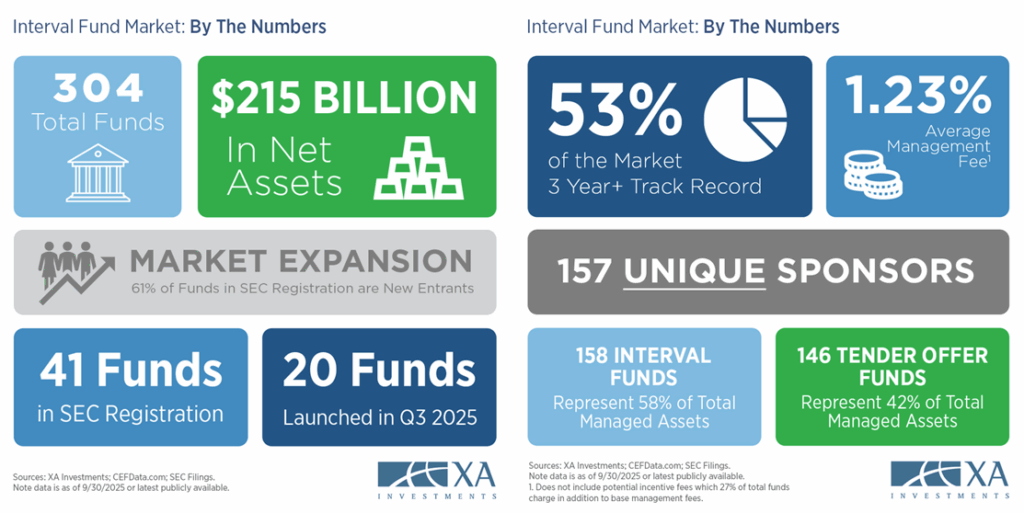
10/15/20025
Quarterly Report Preview: Hedge funds are a significant part of the non-listed closed-end fund universe with 35 funds and $33.1bn in AUM. This quarter’s research highlights strategies represented in the category and examines recent net flow activity. Subscribe to XAI’s Quarterly Research Report to learn more.

10/14/2025
Quarterly Report Preview: The recent Trump Executive Order on 401(k) plans could open the door for private equity and other alternatives in retirement accounts. To learn more about how this development may affect the interval and tender offer fund market, subscribe to XAI’s quarterly research report.

10/12/2025
Quarterly Report Preview: The interval / tender offer fund market now stands at $215 billion in net assets as of 9/30/2025. The interval fund market is growing quickly, with a 33% increase from the previous year and a 10% increase in net assets over the previous quarter.

10/9/2025
Quarterly Report Preview: Curious which firms are entering the interval and tender offer fund market? Subscribe to XAI’s Quarterly Research Report to learn more about the latest entrants and how they are positioned within the market.

10/7/2025
Quarterly Report Preview: The interval fund market now stands at 304 funds with $251 billion in total managed assets as of 9/30/2025. Credit funds continue to lead the way in both the number of funds and total managed assets.

10/5/2025
Quarterly Report Preview: The interval fund market has now surpassed 300 funds marking a new milestone! To see the latest entrants and track market growth, subscribe to XAI’s quarterly research report.

9/25/2025
Credit interval funds represent the largest asset class with $117.4 billion in total managed assets, accounting for 45% of the interval fund market. Venture/Private Equity follows with 25%, while Hedge Fund and Real Estate / Real Asset represent 13% and 11% respectively.
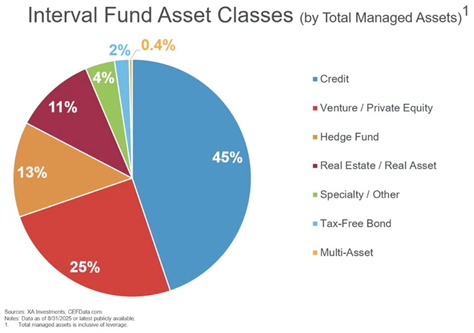
9/18/2025
The interval fund market leaders are Cliffwater, Partners Group, Alkeon Capital Management and StepStone. The 20 largest interval and tender offer funds each have over $2.8bn in total managed assets and together comprise 63% of the market by total managed assets.

9/11/2025
The interval and tender offer fund market is becoming more accessible for a wide range of investors! In Q2 2025, 14 interval and tender offer funds removed their accredited investor suitability restrictions after SEC Staff changes. More accreditation removals are expected throughout the rest of the year.

9/9/2025
It’s a tie! The number of interval funds (144 funds) has caught up to the number of tender offer funds (144 funds). The number of interval funds increased 52% since December 2023, compared to tender offer funds increasing 24% over the same period.

9/2/2025
The number of unique fund sponsors in the interval fund market is growing. 12 new interval fund sponsors have entered the market in 2025. XAI predicts there will be approximately 30 new interval fund sponsors by year end.

8/28/2025
💡 XA Investments LLC advises its interval fund consulting clients to develop and regularly update comprehensive marketing materials. While most interval funds have a basic fund website or fact sheet, it is surprising how many interval funds are missing an opportunity to educate and inform new potential investors. These materials should include a dedicated fund website, a fact sheet, an investor presentation, and additional educational content. Providing important information such as leverage percentages and distribution rates can enhance investors' understanding of funds in the market.
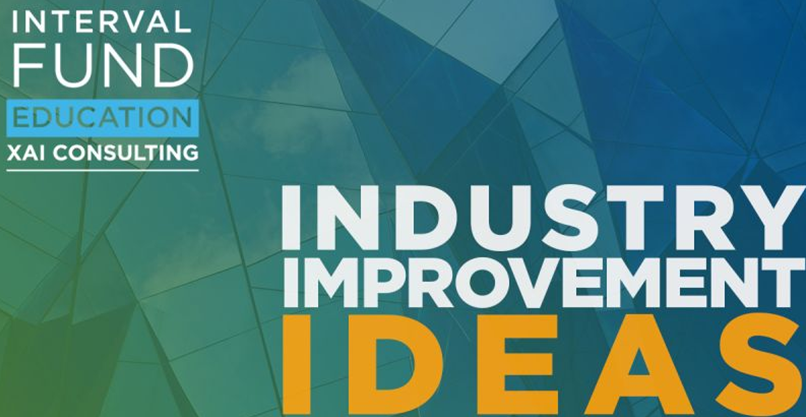
8/26/2025
The pipeline of new interval and tender offer funds has grown to 58 funds in the SEC registration process as of 7/31/25. XAI observes 28 repeat sponsors in the pipeline, including Capital Group, Calamos, and Hamilton Lane. New first-time fund sponsors include, among others: Lincoln Financial, Man Group, and Blue Owl. (Data as of 7/31/2025)
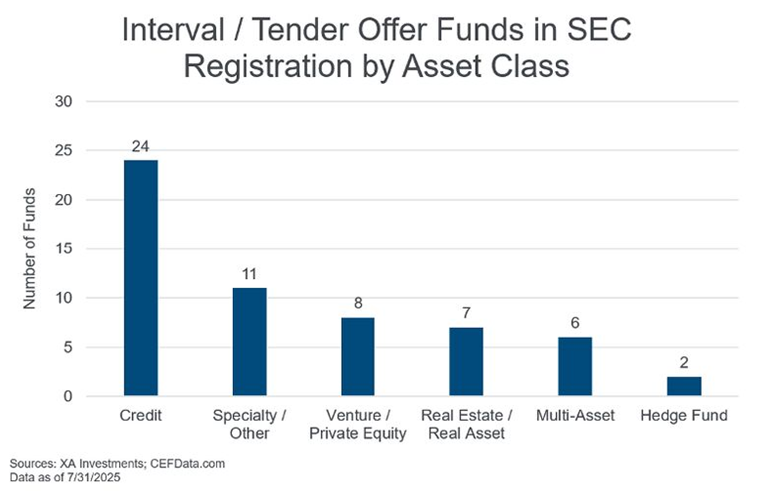
8/12/2025
Net flows across the interval and tender offer fund market increased by $2.6bn quarter-over-quarter, from $11.01bn in Q4 2024 to $13.65bn in Q1 2025. Credit drove the majority of the increase, followed by gains among Venture/Private Equity.
Note: Net flows are based on Form NPORT-P filings as of 3/31/2024 and represent the most recent publicly available data. NPORT filings are typically lagged 60 days from the end of the reporting period.
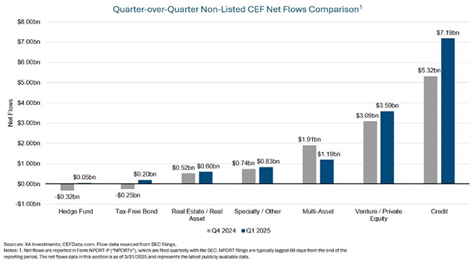
8/11/2025
After a slow start to the summer, new interval and tender offer SEC filings are picking up. From June to July, there was a 200% increase in new filings, with more filings expected for the rest of 2025.
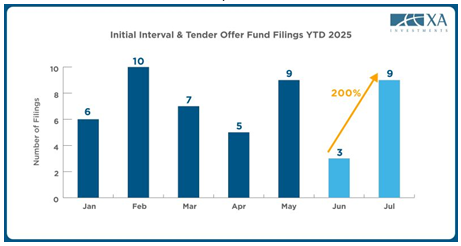
8/7/2025
Management fees across the non-listed CEF market are typically between 1.00% and 1.50%. Net expense ratios vary more widely, driven by some strategies charging incentive fees or underlying private fund fees. Due to leverage, credit funds have the highest average net expense ratio (2.84%), followed by Venture/Private Equity (2.55%) and Multi-Asset strategies (2.48%).
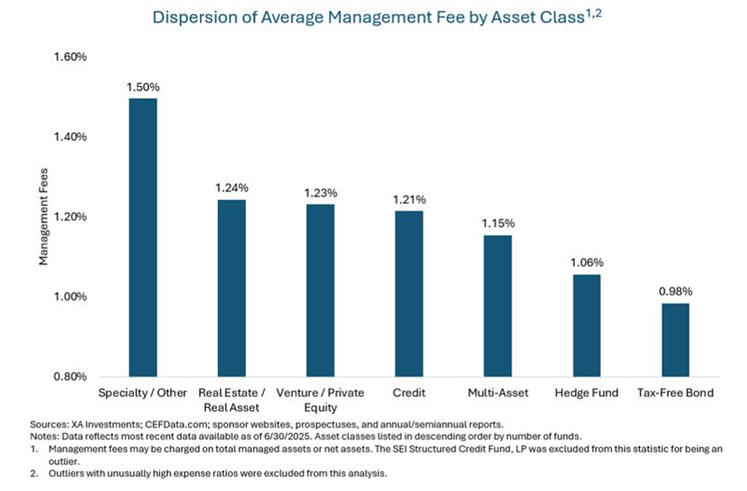
8/6/2025
The non-listed closed-end fund market continues to mature, with more funds reaching longer performance milestones. As of 6/30/2025, 78% of funds have at least a 1-year track record, 55% have reached a 3-year track record, and 38% now have a 5-year track record.
While earlier success in the market may have been driven by manager brand names and broader historical results, the maturation of the market is now leading to a growing preference for managers with established track records.
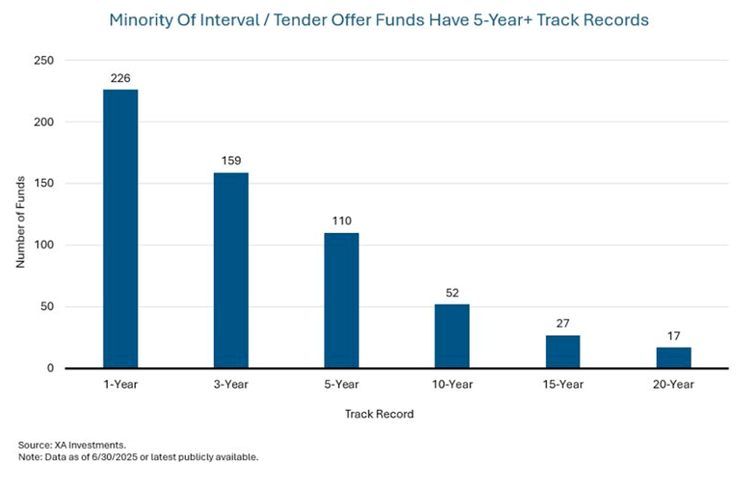
7/31/2025
67% of interval and tender offer funds reported positive net flows in Q1 2025. Credit and Venture/Private Equity strategies led the market, with 71 and 28 funds, respectively, posting positive net flows. In contrast, Hedge Funds saw the highest concentration of funds experiencing outflows, with 13 of 31 funds reporting negative net flows.
Note: Net flow data is sourced from Form NPORT-P filings and reflects the latest publicly available data as of 3/31/2025. NPORT filings are typically lagged 60 days from the end of the reporting period.
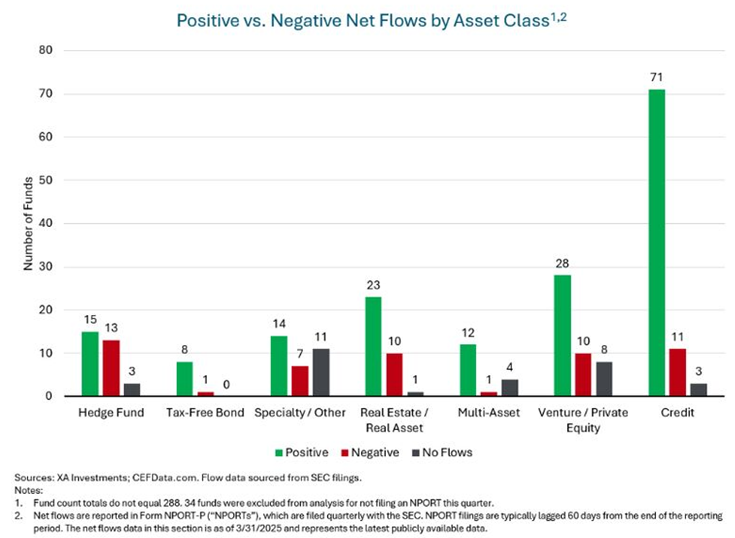
7/29/2025
In Q1 2025, the non-listed CEF market saw positive net flows across all asset classes. Credit and Venture/Private Equity strategies led the non-listed CEF market when it came to net flows in Q1 2025. Credit funds raised $7.19bn across 85 funds, while Venture/Private Equity strategies gathered $3.59bn across 46 funds.
Note: Net flows are sourced from Form NPORT-P filings and reflect data as of 3/31/2025, the latest publicly available information. NPORT filings are typically lagged 60 days from the end of the reporting period.
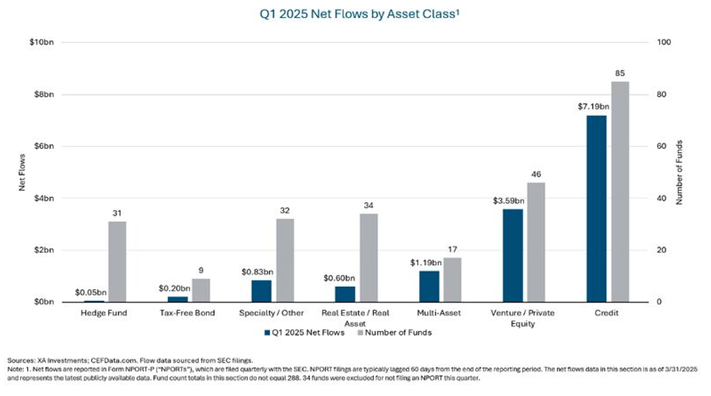
7/23/2025
Now totaling 288 funds, the interval and tender offer fund universe continues to expand, drawing increased attention from asset managers and investors. This quarter’s report highlights key market data and developments, including regulatory changes, net flows, new fund launches, and other emerging trends.
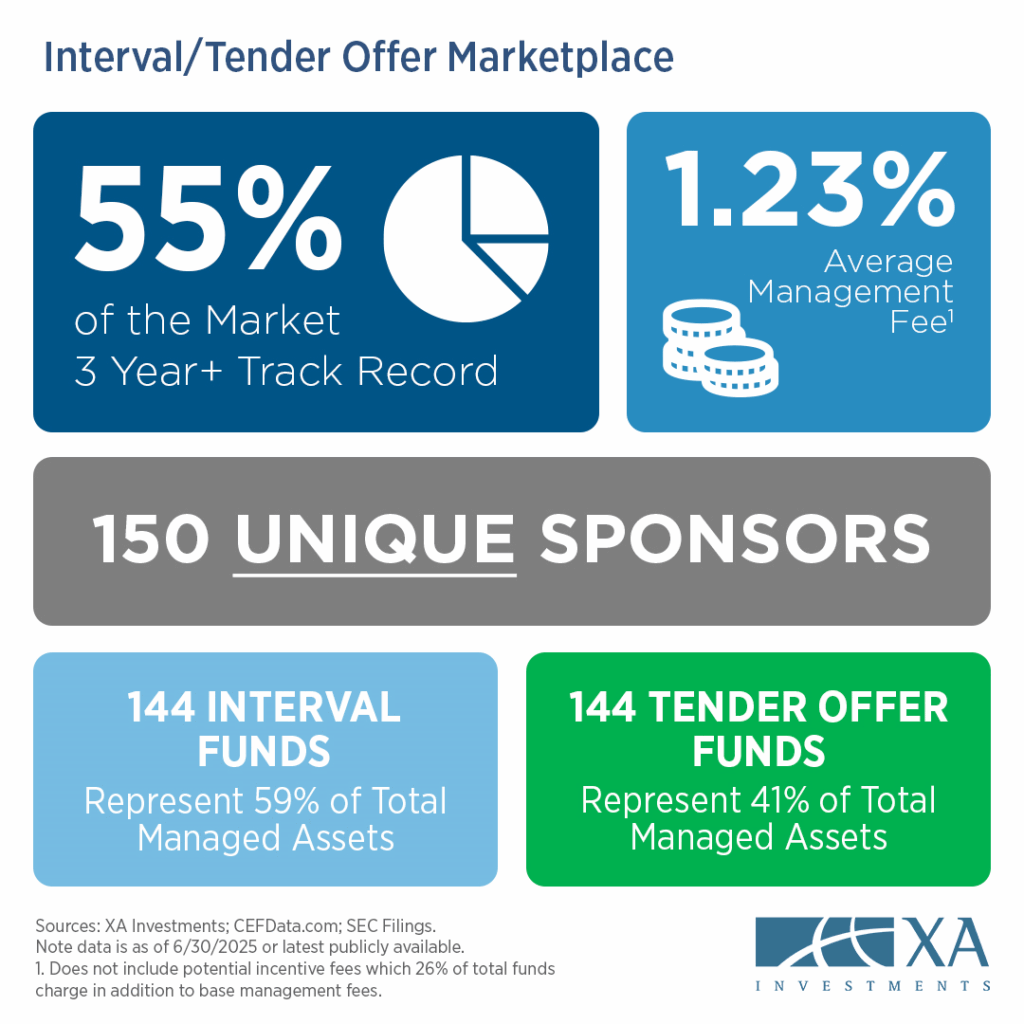
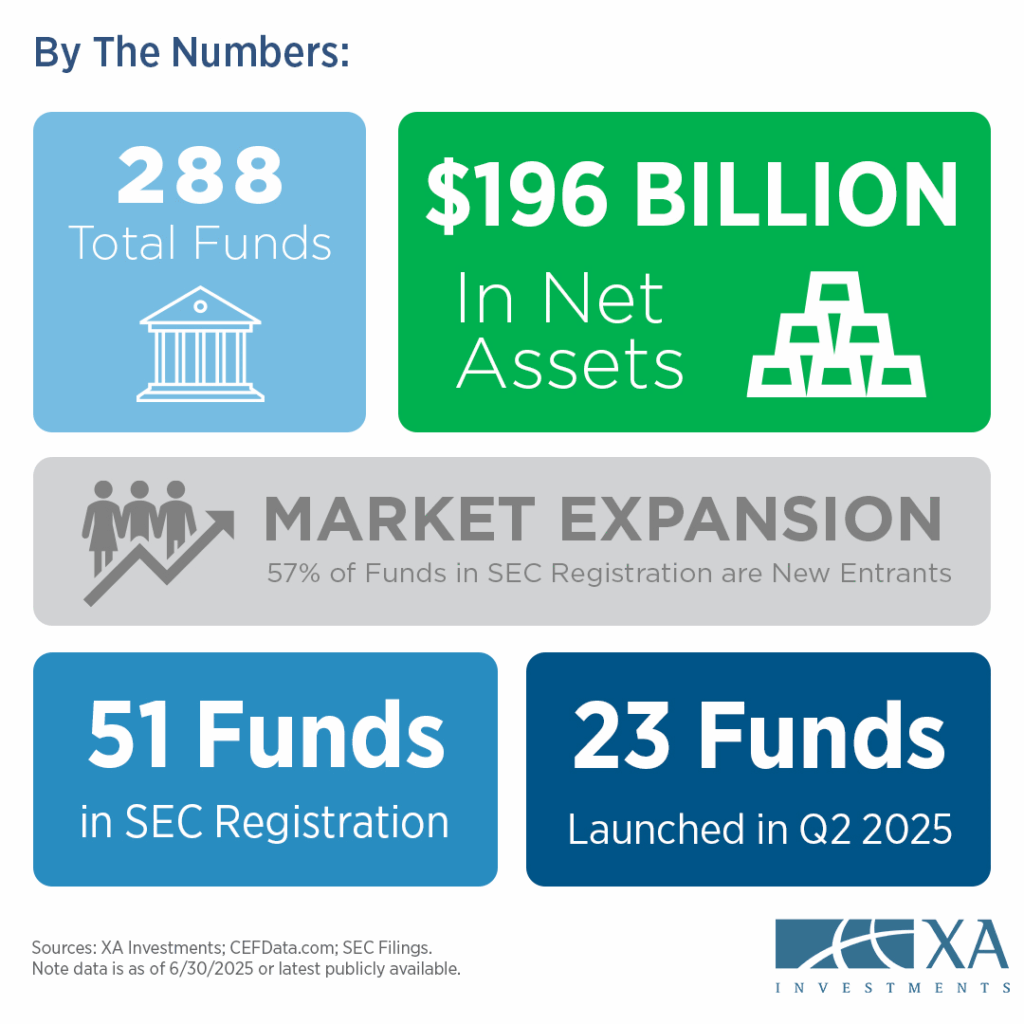
7/20/2025
Quarterly Report Preview: The use of leverage to enhance income and increase total returns is becoming more commonplace among credit interval funds. See which credit interval funds are using leverage in the upcoming XA Investments Quarterly Research Report.

7/17/2025
Quarterly Report Preview: Who’s new in the interval / tender offer fund market? Learn about the 17 new interval fund SEC filings, the 23 new interval funds launched in Q2 2025, and more in the upcoming XA Investments Quarterly Research Report.

7/15/2025
Quarterly Report Preview: Curious about whether or not your interval fund fees are competitive? Learn about management fee ranges, performance fee ranges, and more in the upcoming XA Investments quarterly research report.

7/13/2025
Quarterly Report Preview: The world of alternative evergreen fund structures is expanding. Learn more about some of the Evergreen Specialty Structures including Retail 3(c)(7) Funds and more in the upcoming XA Investments Quarterly Research Report.

07/10/2025
Quarterly Report Preview: The interval / tender offer fund market has $196 billion in net assets as of 6/30/2025. The interval fund market is growing quickly, with a 31% increase from the previous year and an 8% increase over the previous quarter.
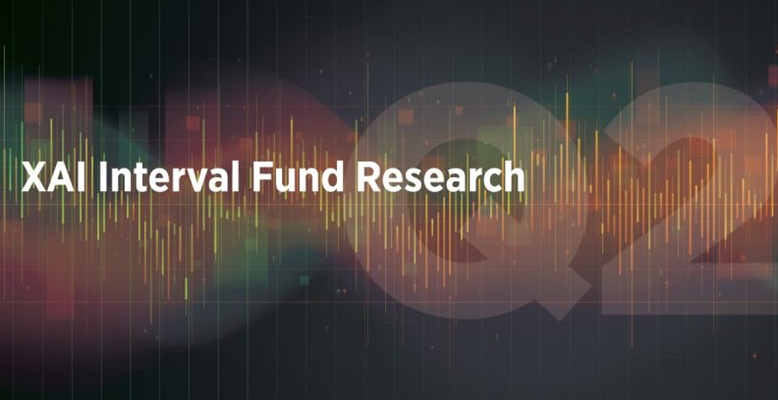
07/08/2025
Quarterly Report Preview: The removal of the unwritten SEC rule limiting CEFs’ ability to invest in private funds without suitability restrictions has led many funds to remove accredited suitability restrictions. To learn which interval funds are removing their suitability restrictions, subscribe to XAI’s quarterly research report.
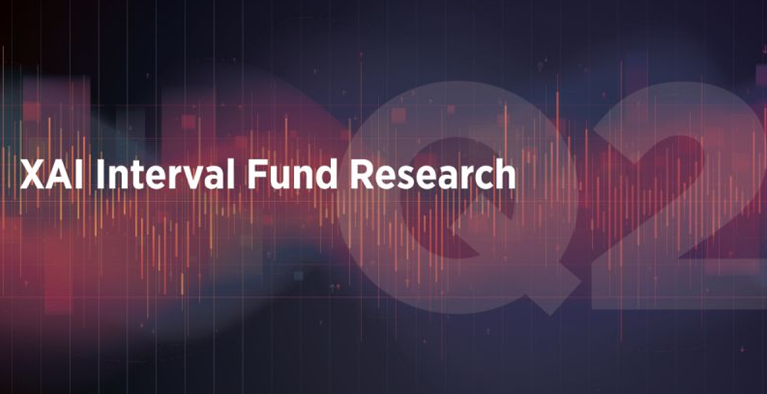
07/02/2025
The interval fund market now stands at 288 funds with $227 billion in total managed assets as of 6/30/2025. Credit funds continue to lead the way in both the number of funds and total managed assets.
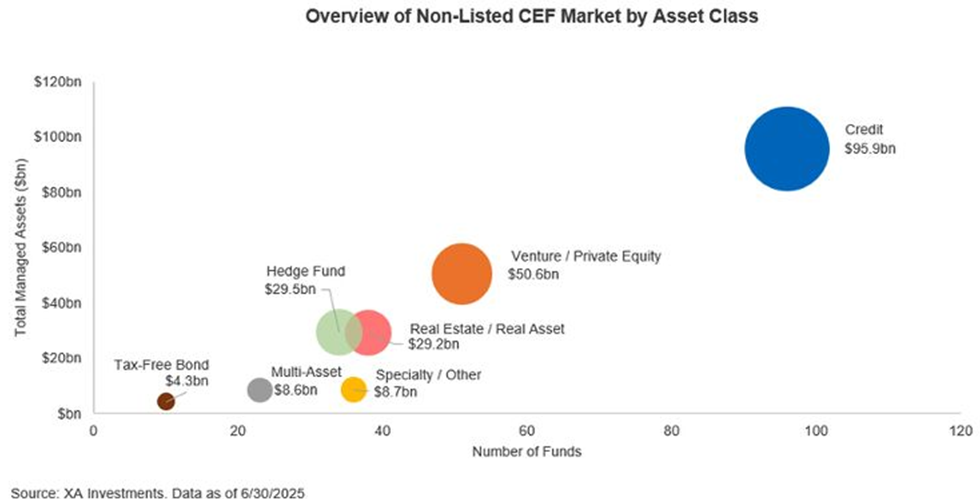
06/27/2025
XAI observes that an interval fund that is broadly salable attracts the greatest net flows. Nearly half (49%) of interval/tender offer funds do not have any fund-level suitability restrictions; 30% are open to accredited investors, and 21% are open to qualified clients. Funds without suitability restrictions raise capital more effectively, accounting for 53% of interval fund market net flows in 2024.
Note: NPORT data is typically lagged by 60 days from the end of the reporting period. The data in this post is as of 12/31/24 and represents the latest publicly available data as of year-end.
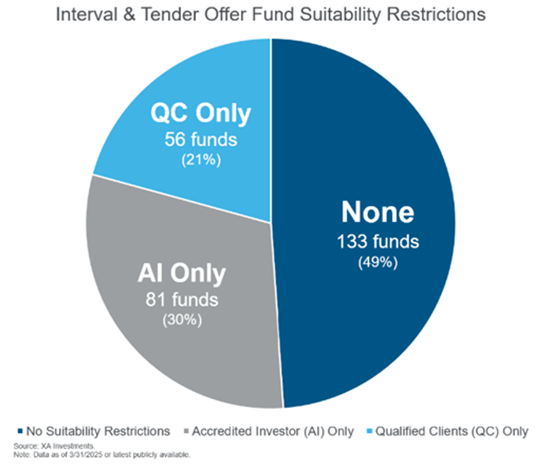
06/18/2025
The non-listed closed-end fund (CEF) market has experienced continued growth in new product launches over the past decade. Since 2015, a total of 250 interval and tender offer funds have entered the market (132 interval funds and 118 tender offer funds). The number of funds launched has accelerated in recent years, with 2024 marking the highest number of launches (50) in a single year. (Data as of 3/31/2025)
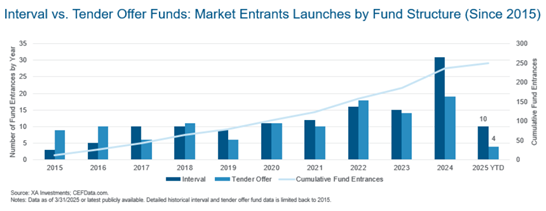
06/17/2025
2024 was a record year for interval and tender offer fund net flows with credit funds bringing in over $20.91bn. Direct Lending funds led the credit category with $9.85 billion in net flows, followed by Multi-Strategy Credit funds with $6.64 billion.
Net flows are reported in Form NPORT-P (“NPORTs”), which are filed quarterly with the SEC. NPORT filings are typically lagged 60 days from the end of the reporting period. The net flows data above are as of 12/31/2024 and represents the latest publicly available data. Chart represents credit fund net flows from 1/1/2024 to 12/31/2024.
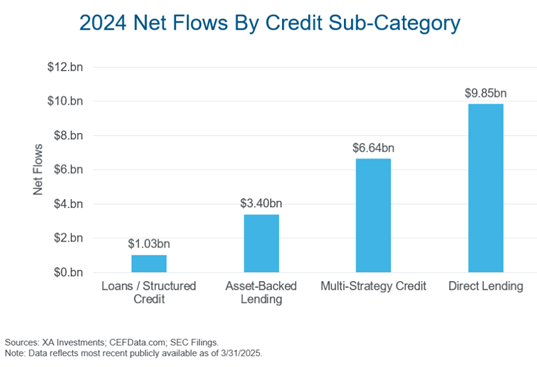
06/12/2025
Interval funds represent 60% ($132.1 billion) of the $220.4 billion in total managed assets across non-listed CEFs, despite accounting for only 50% of funds by count. Credit funds make up the largest segment of interval funds by AUM with $88.5 billion, while Venture/Private Equity funds dominate the tender offer fund structure with $43.9 billion.
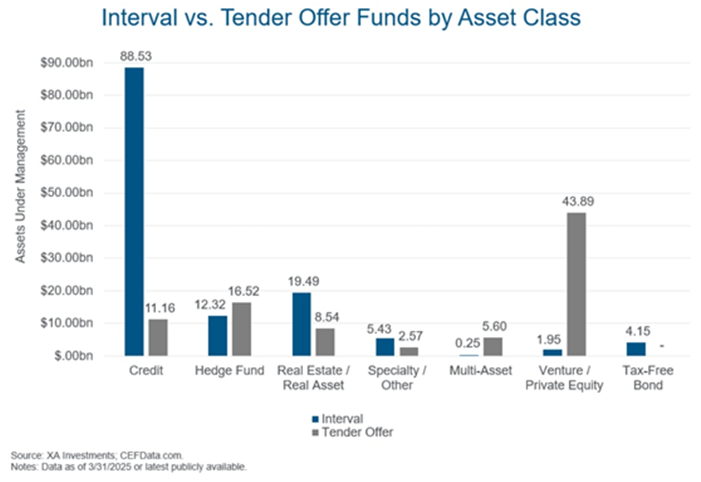
06/10/2025
The interval and tender offer fund market net assets have grown at a 15% compounded annual growth rate over the past decade. Combined net assets rose from approximately $44 billion in 2015 to over $180 billion by Q1 2025. Both interval and tender offer fund structures have contributed meaningfully to this long-term growth. (Data as of 3/31/2025)
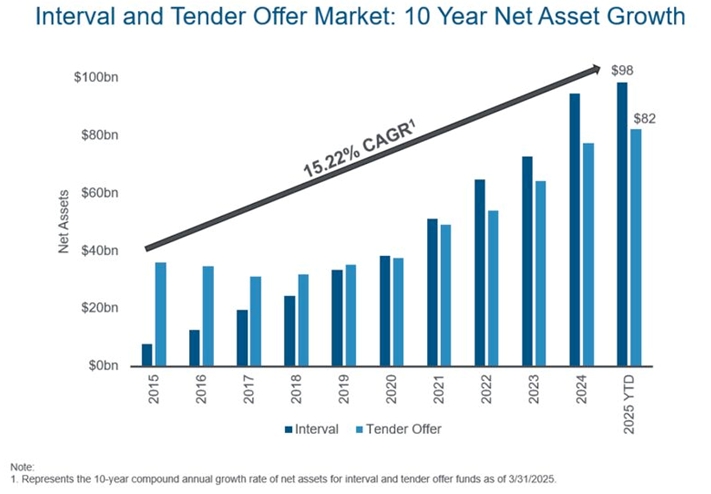
06/06/2025
Credit funds represent the largest asset class in the interval and tender offer fund market, with $99.7 billion in total managed assets, accounting for 45% of the market. Venture/Private Equity follows with 21%, while Hedge Funds and Real Estate strategies each hold 13%.
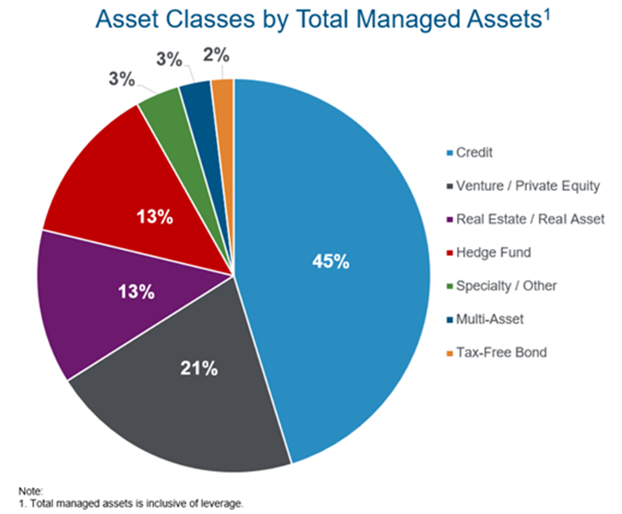
06/03/2025
Alternative asset managers continue to dominate the interval fund market in AUM and number of funds ($155bn in AUM and 150 funds). Traditional asset managers have struggled to raise capital as effectively with $43bn in AUM across 87 funds. Other specialty firms have gathered $22bn in AUM across 33 funds.
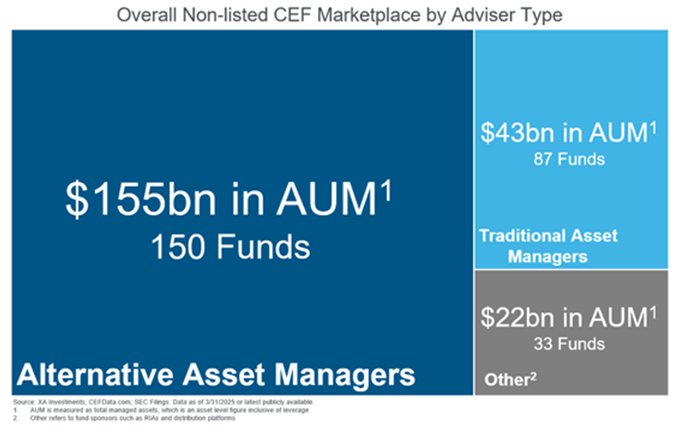
5/29/2025
The pipeline of new interval and tender offer funds has grown to 58 funds in the SEC registration process as of 3/31/25. In the pipeline, XAI observes 27 repeat sponsors including iCapital, Brookfield, and Carlyle. New first-time fund sponsors include, among others: Blue Owl, Raymond James, and CAIS. (Data as of 3/31/2025)
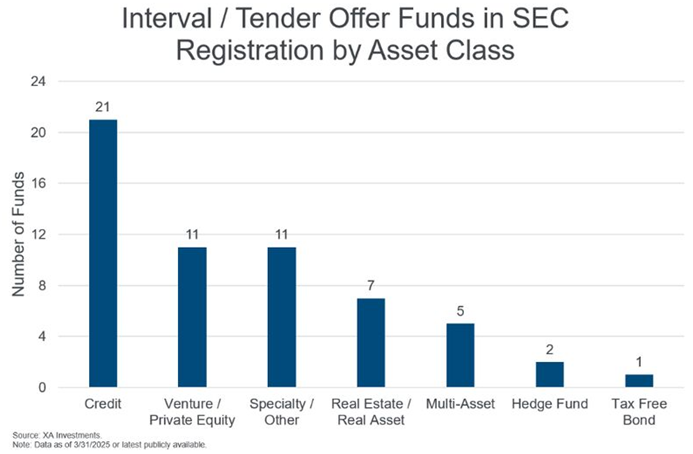
5/27/2025
There are 143 unique sponsors in the Interval/Tender Offer fund marketplace. Out of the 143 sponsors, 50 sponsors have two or more funds, with 27 existing sponsors in SEC registration now and planning to launch another fund. (Data as of 3/31/2025)
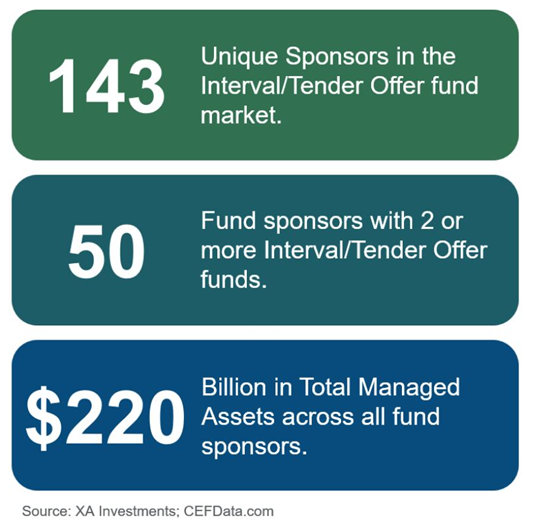
5/13/2025
💡 Industry Improvement Idea: Interval and tender offer fund sponsors should check their fund description on Bloomberg to make sure that it includes the fund’s structure. It is important to explicitly state that the fund is either an interval fund or a tender offer fund so that Bloomberg users understand the fund’s structure and liquidity features. Including the fund’s structure in the description also allows Bloomberg users to pull up lists of comparable funds with the same structure. Bloomberg permits changes from fund sponsors who want to improve their fund descriptions for searchability or for marketing reasons.

4/25/2025
Quarterly Report Highlight: Want to learn why some interval fund sponsors are conducting simultaneous offerings under the 1940 and 1933 act for the same fund? See the case study in the XA Investments Quarterly Research Report.
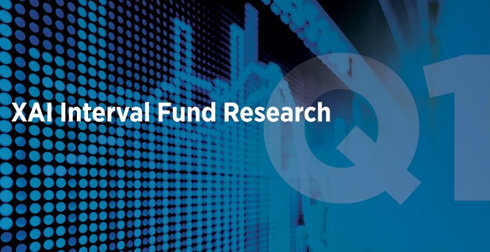
4/24/2025
Quarterly Report Highlight: Over the past year, net flows have increased by 84% year-over-year, with more than $20 billion raised in the Credit asset class alone. Discover deeper insights into the net flows of the interval / tender offer fund market in the XA Investments Quarterly Research Report.
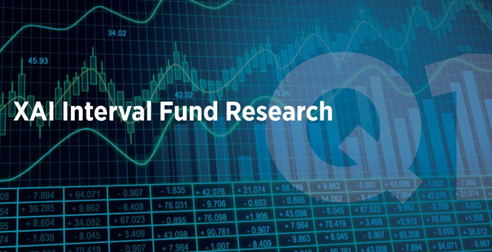
4/23/2025
The XA Investments LLC Q1 2025 Quarterly market research report is now available in the XAI Knowledge Bank. In the report learn about the 270 interval / tender offer funds in the market, changes in the SEC, 2024 net flows, and more.
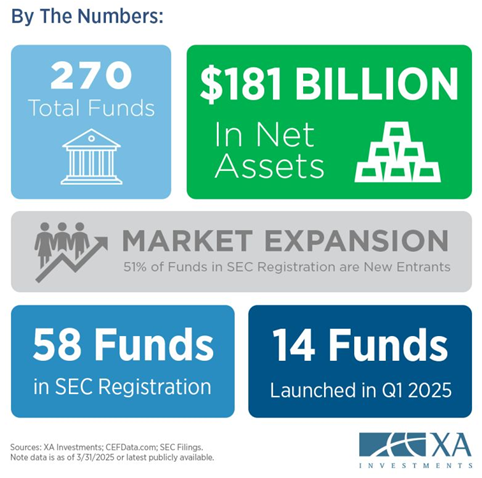
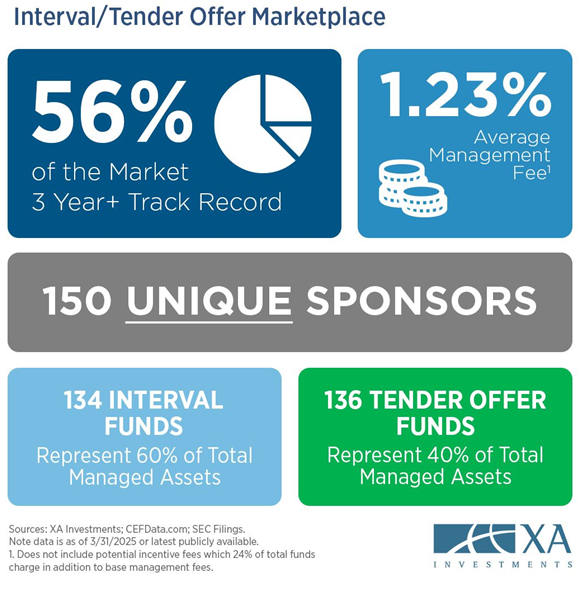
4/17/2025
Quarterly Report Preview: What’s new in the interval / tender offer fund market? Learn about the 23 new SEC filings, the 14 new funds launched in Q1 2025, and more in the upcoming XA Investments Quarterly Research Report.
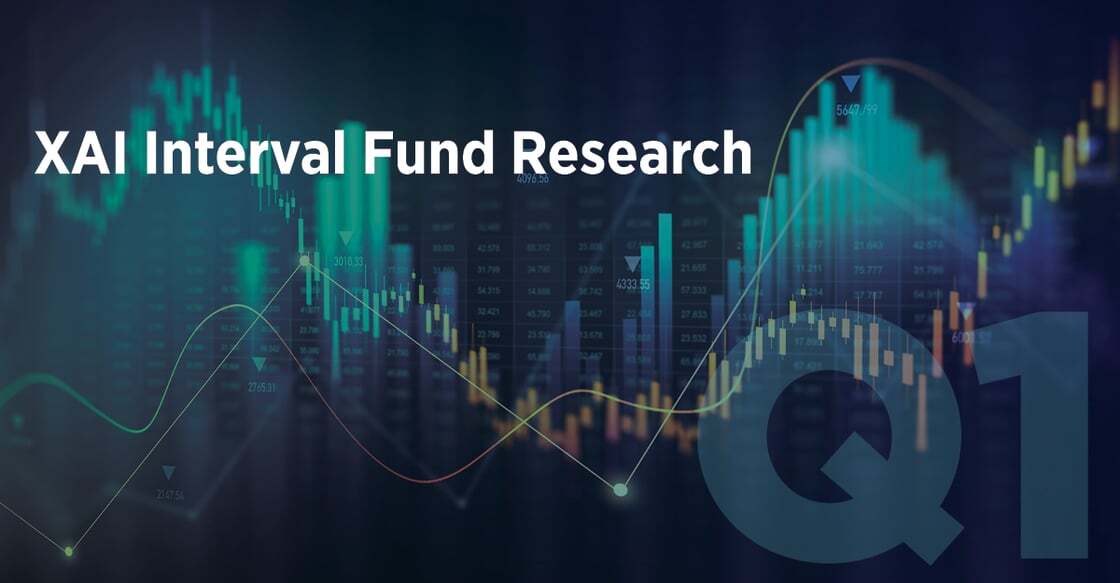
4/16/2025
Quarterly Report Preview: In Q1 2025, the number of new interval fund filings increased by over 53% compared to Q1 2024, rising from 15 to 23 funds.
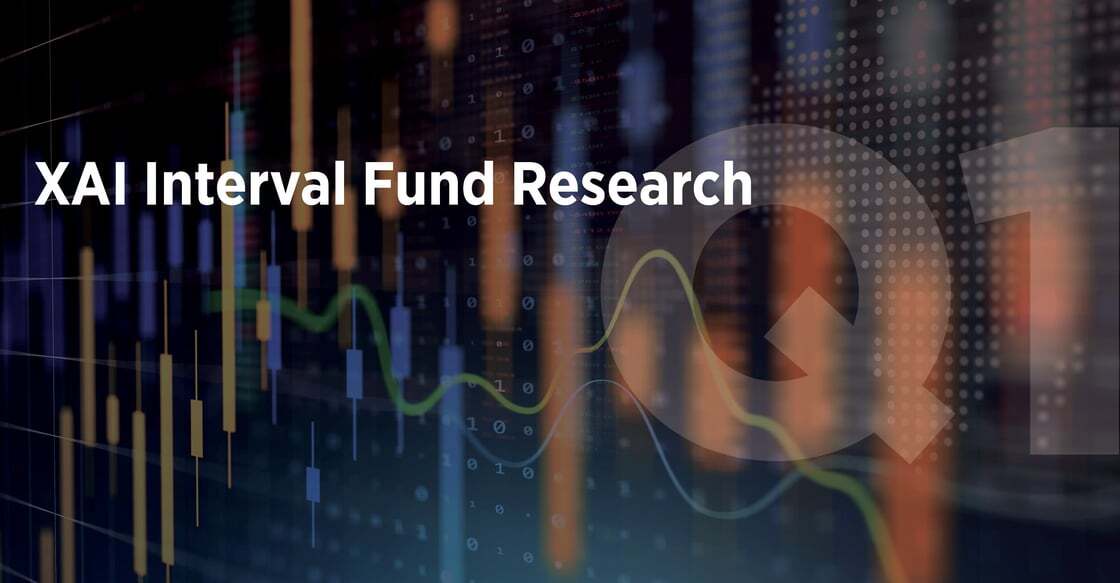
4/15/2025
Quarterly Report Preview: 2024 was a big year for capital raising in the interval and tender offer fund market, with the market bringing in over $39 billion in net flows. Net flows data is typically reported on a 60-day lag after the quarter end for each fund. To receive full coverage of 2024 year-end net flows, subscribe to XA Investment’s proprietary research.
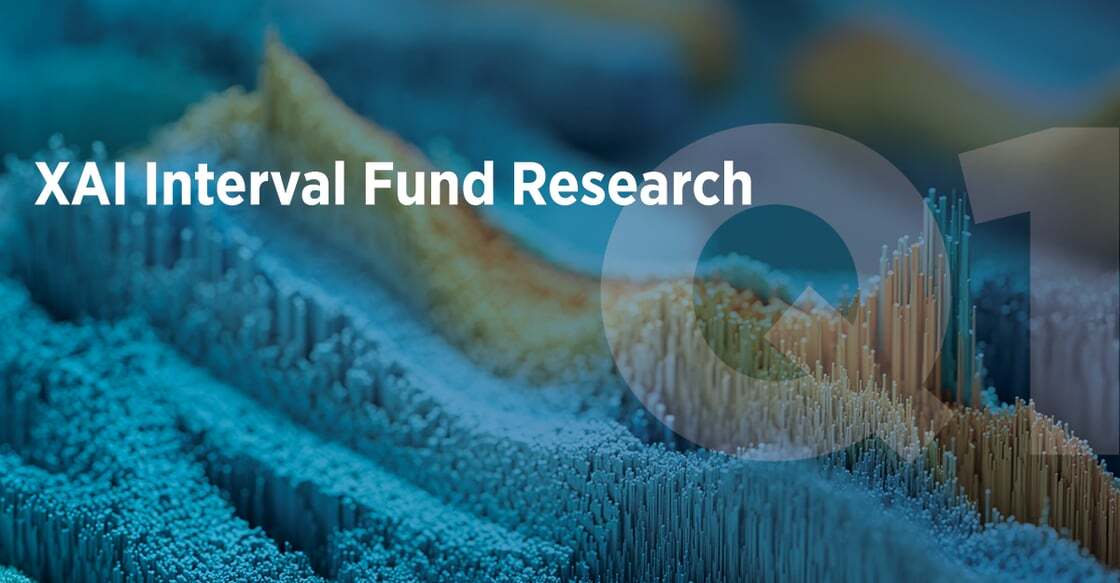
4/8/2025
In 2024, 50 funds entered the market, and 80 funds filed with the SEC. Among these, funds were filed or launched by leading alternative investment managers Ardian, Coatue, Coller Capital, Select Equity, and Stonepeak.

4/4/2025
💡Industry Improvement Idea: XAI encourages interval and tender offer fund sponsors to educate and to constructively explain the differences in the interval and tender offer fund structures. It serves the industry well to speak in a positive way about the differences as some interval fund sponsors may see themselves launching a tender offer fund down the road.

3/27/2025
In 2024, the interval fund industry rapidly expanded with 50 fund launches and just 5 closures - the highest and lowest, respectively, in the past decade! This trend surpasses the ten-year average by 25 more openings and 8 fewer closures.🚀

3/25/2025
The interval fund market now stands at 265 total funds with $178bn in net assets, reflecting a net gain of 8 funds and $6bn in net assets in 2025 YTD (as of 2/28/2025).

3/20/2025
💡 Industry Improvement Idea: Quarterly NPORT filings provide valuable data for investors and market observers and many market participants will scrape the data since it is reported in a standardized form. We encourage all fund sponsors to review these filings more thoroughly as NPORT data becomes more heavily relied upon throughout the industry.

3/18/2025
The interval fund market now stands at 265 funds with $219 billion in total managed assets as of 2/28/2025. Credit funds continue to lead the way in both the number of funds and total managed assets.

03/13/2025
The top 10 interval / tender offer funds have each surpassed $4 billion in managed assets as of 12/31/2024, totaling over $100 billion across the 10 funds. This represents an 8.5% (~$8 billion) increase over the previous quarter’s results.

03/11/2025
💡 Industry Improvement Idea: XAI observes that more funds have been using leverage to enhance income and increase total returns. XAI encourages interval and tender offer fund sponsors to consider improving their disclosures regarding the use of leverage, including adding leverage ratios to their fund fact sheets and fund.

03/06/2025
There were 80 total new interval / tender offer fund SEC filings in 2024 compared to 45 total new fund SEC filings in 2023. This represents a 77% (35 fund) year-over-year increase with more funds expected to be filed in 2025.

03/04/2025
Alternative asset managers continue to dominate the interval fund market in AUM and number of funds ($146bn in AUM and 146 funds). Traditional asset managers have struggled to raise capital as effectively with $41bn in AUM across 80 funds. Other specialty firms have gathered $21bn in AUM across 31 funds.

02/27/2025
XAI observes that an interval fund that is broadly saleable gains the most sales traction. Nearly half (47%) of interval/tender offer funds do not have any fund-level suitability restrictions; 32% are open to accredited investors, and 21% are open to qualified clients. Funds without suitability restrictions raise capital more effectively, accounting for 54% of 2024 YTD (1/1/24 – 9/30/24) net flows.
Note: NPORT data is typically lagged by 60 days from the end of the reporting period. The data in this post is as of 9/30/24 and represents the latest publicly available data as of year-end.

02/25/2025
The pipeline of new interval funds has grown to 53 Interval/Tender Offer funds in the SEC registration process as of 12/31/24. In the pipeline, XAI observes 26 repeat sponsors including Hamilton Lane, Morgan Stanley, and BlackRock. New first-time fund sponsors include, among others: Segall Bryant & Hamill, Coatue Management, and Global X. (Data as of 12/31/2024)

02/20/2025
Tender offer funds represent 52% of the 257 total non-listed CEFs in the marketplace. Among the tender offer funds, Venture / Private Equity funds (42 or 32%) are the most prevalent. Among the interval funds Credit funds (63 or 51%) are the most prevalent.

02/18/2025
FAQ: Q: What is the main difference between an interval fund and a tender offer fund? A: Shareholder liquidity. With that said, we maintain that these sister structures are very similar. Check out the table below to learn more about the structural differences between interval and tender offer funds.

02/13/2025
There are 146 unique sponsors in the Interval/Tender Offer fund marketplace. Out of the 146 sponsors, 44 sponsors have two or more funds, with 18 existing sponsors in SEC registration now and planning to launch another fund. (Data as of 12/31/2024)

02/11/2025
Some of the interval / tender offer funds that had notable growth and success raising assets in 2024 include the Brookfield Infrastructure Income Fund, the Cascade Private Capital Fund, the Hamilton Lane Private Assets Fund, the AMG Pantheon Credit Solutions Fund, and the StepStone Private Credit Income Fund.

02/07/2025
The 20 largest interval and tender offer funds each have over $2bn in total managed assets and together comprise 65% of the interval/tender offer fund market by total managed assets. The market leaders include Cliffwater, Partners Group, Alkeon Capital Management and PIMCO.

02/06/2025
More than half of all interval and tender offer funds in the marketplace have investment minimums that are $25,000 or below, making the funds accessible for a broad audience of retail investors. Note, no investment minimums exist outside the displayed bounds.

12/20/2024
24% of all funds in the interval and tender offer fund market are subject to income incentive or performance fees. Breaking down the funds: Credit funds make up 81% (26 funds) of funds charging income incentive fees. Venture / Private Equity and Specialty funds account for 61% (17 funds) of funds charging total return or net profit fees.

12/09/2024
Anticipated interval fund market expansion: As of 9/30/2024, 55 new interval/tender offer funds filed their initial registration statement with the SEC so far this year. Credit funds account for 47% of the registrations.

12/06/2024
Year to date, the interval / tender offer fund market has observed 22 new funds launched and $22bn in net asset growth (as of 9/30/2024). Key performance indicators shown below continue to demonstrate strong growth and adoption rates.

12/03/2024
There are 133 unique sponsors in the Interval/Tender Offer fund marketplace accounting for a total of 235 funds. Out of the 133 sponsors, 44 sponsors have two or more funds, with 18 existing sponsors in SEC registration for another fund. (Data as of 9/30/2024)

11/26/2024
The interval and tender offer fund market has continued to grow and mature. Of the 235 funds in the market, 60% of the funds have a 3-year track record and only 21% have a 10-year track record.

11/21/2024
The credit asset class dominated net flows for interval funds in Q2 2024, comprising 57% of the market’s positive flows. Credit funds also outperformed other asset classes on a fund-by-fund level, generating the highest average and median net flow of ~$77mm and ~$19mm, respectively.
Note: Net flows are reported in Form NPORT-P (“NPORT”), which are filed quarterly with the SEC. NPORT filings are typically lagged 60 days from the end of the reporting period. The net flows data in this section is as of 6/30/2024 and represents the latest publicly available data.

11/19/2024
Interval Fund FAQ: What is the typical capital raised in the first year of operation for a new interval fund?
42% of interval funds launched in the last 18 months have met the $100 million asset level. Reaching the $100 million mark is important for new interval funds so they can better cover operating expenses.

11/15/2024
Launching an interval fund? Get ready for a lengthy SEC registration process. XAI observes Credit and Real Estate funds experience a shorter average review process of ~5 months, while Multi-Asset funds take an average of ~10 months.
(Data represents funds launched between October 1, 2023 and September 30, 2024)

11/13/2024
The non-listed CEF marketplace consists of 235 interval and tender offer funds with $162bn in net assets as of 9/30/24. Interval funds make up $89bn (55%) of net assets and tender offer funds make up $73bn (45%) in net assets.

11/08/2024
Alternative asset managers dominate the interval fund market in AUM and number of funds ($134bn in AUM and 129 funds) compared with traditional asset managers ($38bn in AUM and 77 funds) and other specialty firms ($19bn in AUM and 29 funds).

11/06/2024
The pipeline of new interval funds has grown to 53 Interval/Tender Offer funds in the SEC registration process (compared to 39 as of 12/31/23). In the pipeline, XAI observes 18 repeat sponsors including First Eagle, Nuveen, and PIMCO. New first-time fund sponsors include Russell Investment Management, Rockefeller Asset Management, and Global X. (Data as of 9/30/2024)

11/01/2024
Nearly half (46%) of interval/tender offer funds do not have any fund-level suitability restrictions; 31% are open to accredited investors, and 23% are open to qualified clients. Funds without suitability restrictions raise capital more effectively, accounting for 54% of YTD net flows.

10/28/2024
The interval fund market now stands at 235 total funds with $162bn in net assets, reflecting a net gain of 23 funds and $36bn in net assets YTD.

10/25/2024
From a liquidity perspective, the interval fund market is healthy in most asset categories. Credit and Multi-Asset dominated the positive flows, with 85% and 88% of funds experiencing positive flows, respectively. Conversely, Hedge Fund and Real Estate / Real Asset categories continue to experience negative net flows.
Note: Net flows are reported in Form NPORT-P (“NPORT”), which are filed quarterly with the SEC. NPORT filings are typically lagged 60 days from the end of the reporting period.

10/11/2024
With the benefit of electronic ticketing, daily NAV interval funds are leading the way in capital raising. 113 interval and tender offer funds with daily NAVs have attracted $10.8bn in net flows for the period from 12/31/23 to 6/30/24, which represents the most recent publicly available data.
Note: Net flows are reported in Form NPORT-P (“NPORT”), which are filed quarterly with the SEC. NPORT filings are typically lagged 60 days from the end of the reporting period.

10/10/2024
More than half of all interval and tender offer funds in the marketplace have investment minimums that are below $25,000, making the funds accessible for a broad audience of retail investors.

10/04/2024
Collectively, the top 10 interval funds have reached record total managed assets of nearly $96 billion as of 9/30/24. This represents an 11.2% increase over the previous quarter’s results, with the top 10 interval funds each surpassing $4 billion in managed assets.

10/03/2024
Tender offer funds represent 52% of the 235 total non-listed CEF’s in the marketplace. Among the tender offer funds, Venture / Private Equity funds (44) are the most prevalent. Among the interval funds Credit funds (56) are the most prevalent.

09/27/2024
Interval Fund FAQ: Q: What is the main difference between an interval fund and a tender offer fund? A: Shareholder liquidity. Check out the table below to learn more about the structural differences between interval and tender offer funds.

09/25/2024
Over $37bn in net asset growth and 22 new funds have entered the interval fund market YTD (as of 8/31/2024). Other performance indicators, such as those shown below, continue to demonstrate strong growth and adoption by both managers and investors.

09/20/2024
Interval and tender offer fund strategies can impact the time spent in SEC registration. XAI observes, credit and real estate funds experience a shorter average review process of ~5 months, while private equity/venture capital funds take an average of ~13 months (data represents funds launched between June 30, 2023, and June 30, 2024).

09/18/2024
Public/private partnerships are transforming the asset management landscape, enabling firms to leverage each other's expertise and deliver top-tier solutions to investors. Recently, five newsworthy new partnerships have been announced, each offering diverse strategies to meet evolving market demands.

09/13/2024
Anticipated interval fund market expansion: 51 new interval/tender offer funds filed their initial registration statement with the SEC in 2024 YTD. Credit funds account for 45% of the registrations.

09/10/2024
The interval fund market now stands at 234 funds with $192 billion in total managed assets as of 8/31/2024. Credit funds continue to lead the way in both the number of funds and total managed assets.

09/03/2024
The interval and tender offer fund market has continued to grow and mature. Of the 230 funds in the market, 83% have reached a 1-year track record, 60% have reached a 3-year track record. While 45% and 21% have reached a 5- and 10-year track record, respectively.
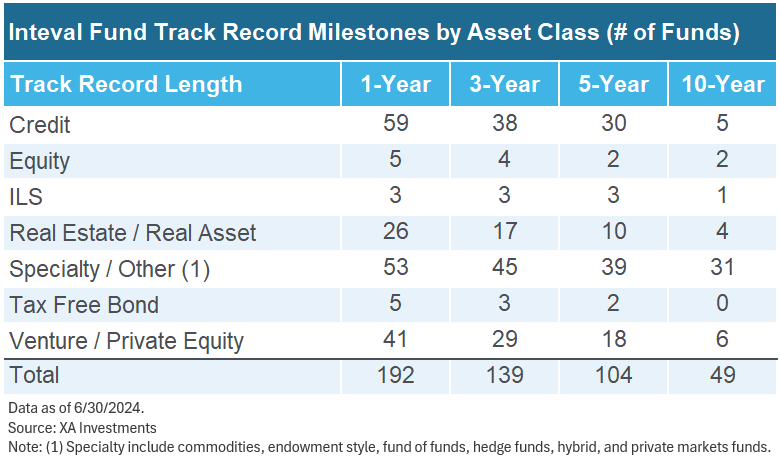
08/30/2024
Suitability restrictions among interval and tender offer funds vary based on a number of key factors. Currently, nearly half (47%) of funds do not have any fund-level suitability restrictions; 31% are open to accredited investors, and 22% are open to qualified clients.

08/29/2024
Strategies and fee structures play a crucial role in defining suitability restrictions for interval and tender offer funds. The chart below highlights the varying levels of suitability, ranging from no restrictions to limitations based on accredited investor or qualified client status.

08/26/2024
The pipeline of new interval funds has grown to 50 Interval/Tender Offer funds in the SEC registration process (compared to 39 as of 12/31/23). In the pipeline, XAI observes several repeat sponsors including First Eagle, Nuveen, and PIMCO. New first-time fund sponsors include HarbourVest, Gemcorp, and Diamond Hill. (Data as of 6/30/2024)

08/23/2024
Net flows for the 20 largest interval and tender offer funds increased by 41% from Q4 of 2023 to Q1 2024. These 20 funds account for 53% of net flows in the entire non-listed CEF universe in Q1 2024.

08/19/2024
In the Interval/Tender Offer fund marketplace, there are 130 unique sponsors for a total of 230 funds. Out of the 130 sponsors, 41 have two or more funds. (Data as of 6/30/2024)

08/16/2024
The interval fund marketplace includes 230 Interval and Tender Offer funds with $150bn in net assets, reflecting a net gain of 18 funds to the market in the YTD. (Data as of 6/30/2024)

08/14/2024
Interval fund management fees are an important consideration for both investors and advisers. For this universe of registered funds, base management fees range from 1.00% to 1.50%, with an average fee of 1.19%.

08/09/2024
On average, new interval funds make three N-2 and/or N-2/A filings and spend an average of 178 days (or ~6 months) in the SEC registration process. Experienced law firms such as Dechert, Clifford Chance, Faegre Drinker, Simpson Thatcher, and Ropes & Gray can help non-listed CEF sponsors manage the legal aspects of the fund formation process.

08/05/2024
In the non-listed interval fund market, 23% of funds are subject to income incentive or performance fees. Breaking it down:
1. Credit funds make up 84% (21 funds) of funds charging income incentive fees.
2. Specialty and venture/private equity funds account for 79% (22 funds) of funds charging total return or net profit fees.
Fee combinations from recent entrants are aligning with these market trends.

08/02/2024
The 20 largest interval and tender offer funds each have over $2bn in total managed assets and together comprise 73% of the interval/tender offer fund market by total assets. The market leaders include Cliffwater, Partners Group, Alkeon Capital Management and PIMCO.

08/01/2024
Comparing interval and tender offer funds, interval funds lead in total managed assets with nearly $102 billion compared to tender offer funds with nearly $73 billion in total managed assets.

07/26/2024
XAI predicts that 235 – 255 interval/tender offer funds will be launched this year, and the net assets market wide will be $160 - $170bn by the end of 2024. Thus far in 2024, the market is poised to meet this expectation as 230 interval/tender offer funds with $150bn in net assets are currently in operation.

07/25/2024
The pace of new interval and tender offer fund filings with the SEC has quickened. New fund filings are up 38% in Q2 2024 compared to Q2 2023.

07/19/2024
The interval fund marketplace continues to grow with private credit funds leading the way. Out of the 10 funds launched this past quarter, 7 have been private credit. XAI observes that over half of these launched funds do not have a fund website. We recommend sponsors create dedicated fund websites to provide important fund information, such as portfolio holdings and current distribution rates.

07/18/2024
Alternative asset managers dominate the market in AUM and number of funds ($121bn in AUM and 126 funds) compared with traditional asset managers ($35bn in AUM and 76 funds) and other specialty firms ($18bn in AUM and 28 funds). Source: XA Investments. Note: Data as of 6/30/2024.

07/10/2024
Morningstar recently published a whitepaper titled Morningstar’s Essential Guide to Interval Funds. The white paper describes the history of the interval fund product structure (not tender offer funds), provides analysis on the current state of the market, and discusses key considerations investors need to make before investing. Kimberly Flynn spoke with Morningstar on background as they developed this paper to help address questions and concerns about the interval fund structure. Click HERE to read the full white paper.
07/09/2024
The number of infrastructure-focused interval and tender offer funds continues to grow. Currently, there are 6 active infrastructure-focused interval / tender offer funds and an additional 5 in the SEC registration process. This trend has been accelerating with 3 of those 5 funds filing their initial registration statements this month.

06/28/2024
On average, new interval funds make three N-2 and/or N-2/A filings and spend an average of 172 days (or ~6 months) in the SEC registration process. Experienced law firms such as Clifford Chance, Dechert, Faegre Drinker, Simpson Thatcher, and Ropes & Gray can help non-listed CEF sponsors manage the legal aspects of the fund formation process.
06/24/2024
XAI has partnered with Cerulli Associates and Closed-End Fund Advisors (CEFdata.com) to improve net flows tracking for the non-listed CEF market. We would like to thank the sponsors already sharing data and encourage others to participate. To participate or for further questions please contact Daniil Shapiro at dshapiro@cerulli.com.
06/17/2024
As of 5/31/2024, there are 227 interval/tender offer funds in the market with $168bn in AUM. Credit funds lead the market in both number of funds and AUM.

06/13/2024
XAI has continued to see an increase in the number of new interval and tender offer fund filings. So far in 2024, 26 interval/tender offer funds have filed their initial registration statement with the SEC. Data as of 5/31/2024.

06/05/2024
Prospective interval fund sponsors often ask us about the top launch challenges. While the top obstacles to launch typically vary by investment strategy, a few we see frequently include valuation, liquidity, and fees/expenses. For additional information on how to best address or avoid some of these obstacles, read our white paper below or contact us at info@xainvestments.com.
Launching an Interval Fund: Clear-eyed approach critical to a successful launch
05/31/2024
Due to the growth in the credit category, XAI has established 4 sub-categories within private credit and categorized funds according to strategy: asset-backed lending, direct lending, global credit, and loans/structured credit. The table below summarizes each category.

05/28/2024
A growing number of interval and tender offer funds celebrated their 3-year, 5-year and 10-year anniversaries in Q1 2024. 39% of the market comprises newer funds that have yet to develop a 3-year track record. Longer firm-specific track records are necessary for key RIA and wirehouse platform approvals.

05/24/2024
Industry improvement idea: XAI observes that many non-listed CEFs do not have dedicated fund websites. We encourage fund sponsors to create dedicated fund websites to provide important fund information, such as portfolio holdings and current distribution rates.
05/23/2024
XA Investments is now able to provide clients with independent 15(c) reports to support fund board approvals and renewals of investment advisory agreements. The SEC’s Division of Examinations recently issued its 2024 examination priorities, and fund advisory fees, including fund boards’ processes for assessing and approving advisory fees, are highlighted as a key focus for the SEC in 2024. Our reports include detailed advisory fee, performance, and operating expense analysis and comparisons with independently determined peer funds. For more information on custom 15(c) reports for registered closed-end funds, please contact us.
05/20/2024
How accessible are alternative investments in the interval fund market? Currently, 46% of non-listed CEFs do not have any fund level suitability restrictions for investors; 32% are available to accredited investors, and 22% are available to qualified clients. Data as of 3/31/24.

05/17/2024
The number of interval and tender offer funds in SEC registration has increased from 38 in Q4 2023 to 42 at the end of Q1 2024.

05/15/2024
There are 28 different interval and tender offer funds available on wirehouse platforms, and the majority are private credit-focused. Morgan Stanley has the most interval and tender offer funds (22) on its platform followed by UBS (13) and Merrill Lynch (10) and Wells Fargo (6). Wirehouse gatekeepers have stated their intentions to onboard more alternative fund options for high-net-worth investors.
05/13/2024
Market leading interval funds continue to grow assets. The largest 20 interval / tender offer funds have all scaled up beyond $2bn in AUM. XA Investments observes that the interval fund market tends to be more democratic for fundraising for new entrants when compared with the non-listed REIT and non-listed BDC markets. Data as of 3/31/24.
05/10/2024
The interval fund marketplace consists of 220 interval and tender offer funds with $140bn in net assets and includes 128 unique fund sponsors, with 38 firms having two or more funds. There are also 42 interval and tender offer funds currently in the SEC registration process. Data as of 3/31/24.

05/09/2024
The interval fund market continues to exhibit strong growth. 10 non-listed closed-end funds launched in Q1 2024 and spent an average of 6 months in registration with the SEC.

05/06/2024
Real estate-focused interval and tender offer funds faced challenges attracting net flows in 2023. The category saw an 82% drop in net flows compared to 2022 from $7.6bn to $1.4bn.

05/02/2024
Two interval funds, the Nuveen Enhanced Floating Rate Income Fund and the Oaktree Diversified Income Fund Inc., have either applied for or been granted exemptive relief to offer monthly repurchases. Monthly repurchases would require shorter notification periods to shareholders and may pose challenges for fund service providers. More importantly, it might lead shareholders to believe that the underlying investments of the fund are more liquid than they are.
04/30/2024
Over the past two years, infrastructure-focused interval and tender offer funds have emerged as a new sub-category within the real estate asset / real asset class. Currently, there are five active infrastructure-focused funds, with an additional two funds in the registration process.

04/29/2024
The Brookfield Luxembourg infrastructure fund was reorganized into the Brookfield Infrastructure Income Fund on 11/1/23. The new fund, a tender offer fund, received in-kind capital contributions of net assets valued at approximately $1.5bn from the predecessor fund in exchange for Class I Shares. With strong global demand for infrastructure, the tender offer fund now has over $2.1bn in assets as of 3/31/24.
04/12/2024
In McKinsey & Company’s new report, Global Private Markets Review 2024: Private markets in a slower era, the firm highlighted the strong performance of private debt in 2023. The report states that “during a turbulent year for private markets, private debt was a relative bright spot, topping private markets asset classes in terms of fundraising growth, AUM growth, and performance.” XA Investments LLC observed the strength of private debt in the interval and tender offer fund market with private credit funds attracting the majority of net flows and being among the top performers compared to other asset classes.
To read the full report, click the link below. For more information on interval and tender offer funds, visit the XAI Knowledge Bank.
McKinsey Report: https://www.mckinsey.com/industries/private-equity-and-principal-investors/our-insights/mckinseys-private-markets-annual-review
XAI Knowledge Bank: https://xainvestments.com/knowledge-bank/

04/04/2024
The pace of new interval and tender offer fund registration statement filings increased in Q1 2024: 15 funds filed in Q1 2024 as compared to just 6 in Q1 2023. The increase in fund filings reflects a combination of activity from established interval fund sponsors and new market participants.

04/02/2024
Interval management fees are an important consideration for both investors and sponsors. Most non-listed CEFs have management fees in the range of 1.00% to 1.50% with a market average management fee of 1.19% (as of 12/31/23). Market leader Cliffwater Corporate Lending Fund charges a management fee on the low end of the range.
03/28/2024
XAI observed M&A activity for several new interval fund market sponsors in 2023. Acquiring companies were motivated to obtain investment expertise from boutique alternatives managers, expand their sales and distribution reach, or gain entry to the non-listed CEF market. For example, Polen Capital acquired DDJ Capital Management in January 2022 before launching its first interval fund, the Polen Credit Opportunities Fund, in August 2023.
03/25/2024
Even though there are only five dedicated insurance-linked securities (ILS) interval funds in the market, two ILS funds made their way into the 2023 list of top 15 performers (as of 12/31/23). Because ILS earn the risk-free rate in addition to reinsurance premiums, ILS can benefit from higher interest rates.
03/22/2024
Strong demand for secondaries and infrastructure has driven product development in the interval fund market. Highlighted below are several interval / tender offer funds in each category that are in the SEC registration process now.
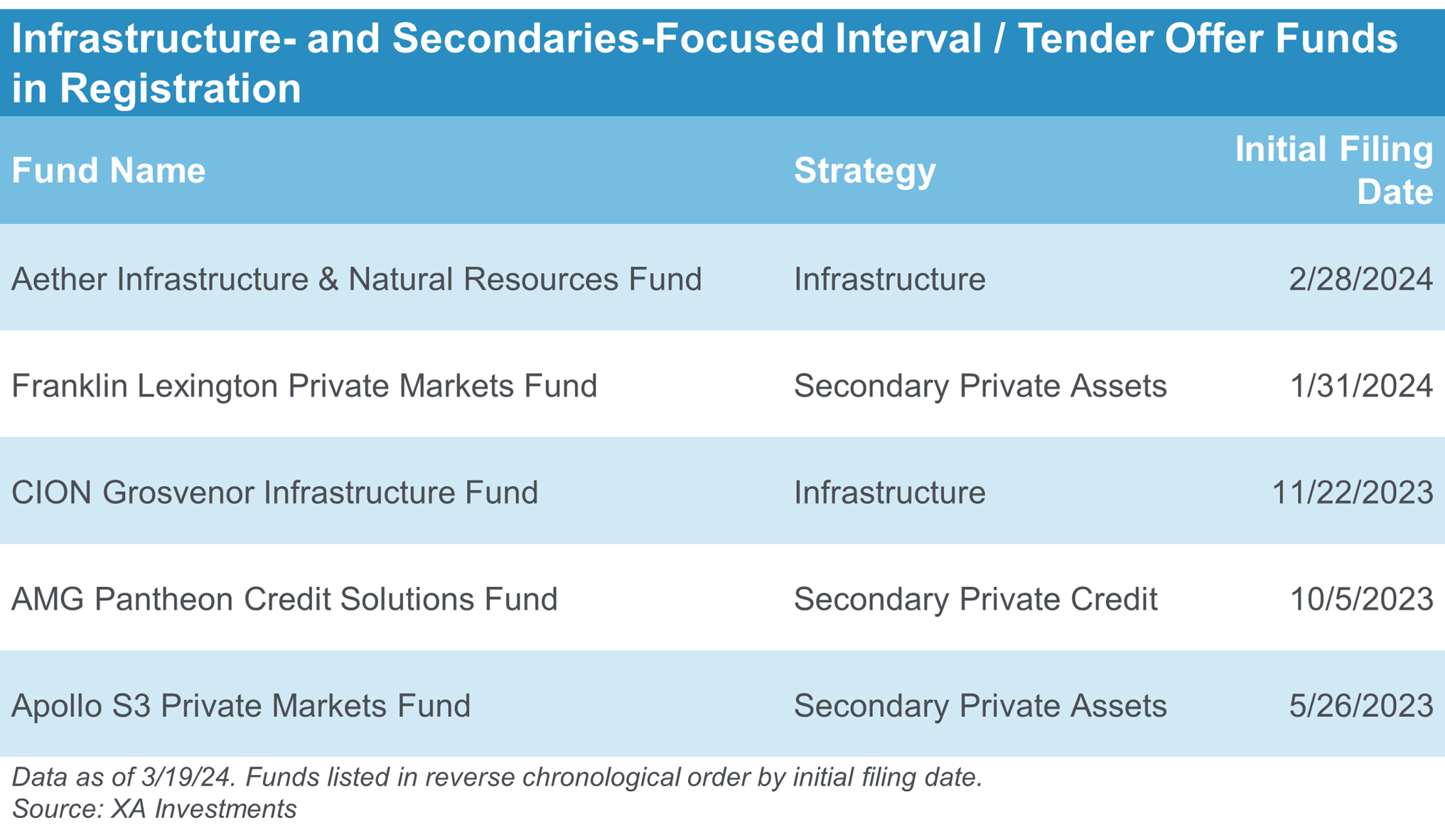
03/19/2024
Asset class appears to be the main driver for the length of the SEC review process, with credit and real estate funds launching faster on average compared to PE/VC funds.
03/11/2024
Market leaders in the alts space are using a variety of structures including non-listed REITs, non-listed BDCs, and non-listed CEFs. Notable examples include Apollo, Ares, Blackstone, Brookfield, and Nuveen.
03/08/2024
XA Investments and Pine Advisor Solutions (PINE)* found that 36% of the interval and tender offer funds in the market use an outsourced chief compliance officer, while only 15% use an outsourced principal financial officer/treasurer. New entrants and firms with a single fund were more likely to outsource these critical functions.
*PINE is a leading advisory support firm focused on advisor compliance support, outsourced CCO/PFO support, distribution services, and operations support. XAI is not affiliated with PINE, but it receives certain services for which it compensates PINE.
03/07/2024
New funds sponsored by KKR, Pender Capital, and Redwood brought in $853mm in net flows after launching in 2023. The KKR fund focuses on asset-backed lending; the Pender and Redwood funds pursue real estate income strategies. Both Pender and Redwood are first-time interval fund sponsors.
02/29/2024
How democratic is fundraising in the interval fund market? The top 20 interval / tender offer funds (by assets) have all scaled up beyond $1.5bn in AUM as of 12/31/23.
02/23/2024
Approximately half of new fund launches in 2023 were private credit funds. Many of these funds feature investor-friendly features such as daily NAV, low suitability restrictions, and low minimum investments.
02/13/2024
For the 12-month period ending 9/30/23, some of the largest interval funds experienced moderating levels of net flows as compared to the same period one year ago. The top 20 funds (ranked by net flows) have seen a combined 15% decrease in net flows over same period.
02/09/2024
Alternative asset managers dominate the interval fund market in AUM and number of funds, with $107bn in AUM and 102 funds, compared with traditional asset managers (with $31bn in AUM and 72 funds) and other specialty firms (with $7bn in AUM and 25 funds).
02/08/2024
The top 15 interval funds all have a 12-month net return of 13.68% or greater (for the period ended 9/30/23). Strong performance in the interval / tender offer fund market continues to encourage growth in existing funds and attract new entrants.
01/29/2024
As the interval fund market continues to grow, more funds are meeting track records thresholds. While only 45% of funds have a 5-year track record, 59% of funds have a 3-year track record, and 84% of funds have a complete 1-year track record.
01/26/2024
XAI has partnered with Cerulli Associates and Closed-End Fund Advisors (CEFData.com) to improve net flows tracking for the non-listed CEF market. We would like to thank the sponsors already sharing data and encourage others to participate. To participate or for further questions please contact Daniil Shapiro at dshapiro@cerulli.com.
01/25/2024
New interval funds on average make three N-2 and/or N-2/A filings and spend an average of 197 days or ~7 months in the SEC registration process. Experienced law firms with several non-listed CEF clients such as Dechert, Faegre Drinker, Simpson Thatcher, Ropes & Gray can help non-listed CEF sponsors manage the time and / or expense of the fund formation process.
01/23/2024
In 2023, new entrants accounted for the majority of fund launches (16 of 25 new funds or 64% of total). Of the funds launched during the year, 12 were Credit-focused, 4 were Real Estate / Real Asset-focused, 6 were Specialty / Other-focused, and 3 were Venture / Private Equity-focused.
01/22/2024
Many prospective interval fund sponsors ask us if the market has become too saturated; As we continue to see the emergence of new asset classes and investor bases in the interval fund market, we believe that there is significant room for additional growth in the interval fund market.
01/19/2024
Did you know that interval funds can be structured as a REIT for tax purposes? The interval/tender offer fund market now has 8+ funds that invest primarily in real estate debt and/or equity securities and are structured as REITs for tax purposes instead of regulated investment companies (RICs). For example, the Clarion Partners Real Estate Income Fund, is a tender offer fund that is a REIT for tax purposes. The Clarion RE tender offer fund was launched in Sept 2019 and currently has $739mm in total managed assets (as of December 2023).
01/18/2024
The pipeline of new interval funds is large with 39 interval/tender offer funds in the SEC registration process as of 12/31/23 (compared with 29 as of 9/30/23). In the pipeline, XAI observes several repeat issuers with fund sponsors including Stone Ridge, PIMCO, and John Hancock in queue. New first-time fund sponsors including Jackson National, Cadre and Alternative Investment Resources.
01/17/2024
Income incentive fees are increasingly being used by credit-focused interval funds to align performance incentives between portfolio managers and investors. 11 of the 20 total interval funds that have income incentive fees have been launched in the last 2 years.
01/08/2024
What does it cost to launch an interval fund? Organizational and offering expenses for a new interval fund are typically paid out-of-pocket by the fund sponsor. Such org/offering costs can vary by asset class and by service providers selected with the bulk of the expense being legal. XAI estimates that org/offering expenses for an interval fund will range from $500,000 to $750,000. Let us know if we can help with your economic modeling and break-even analysis.
01/05/2024
Turnkey platforms with existing fund boards in place are becoming increasingly popular for interval fund sponsors who are looking to save time and money in launching their first interval fund. Firms like RRB, UMB, and Ultimus can be great partners in the interval fund formation process. Let us know if you need more information on the benefits of a turnkey platform with a shared fund board and service providers.
01/03/2024
Did you know? XAI has a diverse database of experienced fund board candidates for new interval fund boards. Reach out if you are looking to stand up a new board and want to interview professionals with alternative investments and registered fund expertise.
12/29/2023
Secondaries-focused interval funds are expected to gather assets in 2024, with several interesting funds in the registration now including Apollo S3 Private Markets Fund, Coller Secondaries Private Equity Fund and the AMG Pantheon Credit Solutions Fund.
12/27/2023
Launched in 2009, the Partners Group Private Equity Fund is the largest tender offer fund with $14bn+ in AUM. This market leading tender offer fund is available on several different wirehouse platforms including Merrill Lynch, Morgan Stanley and Wells Fargo.
12/21/2023
Interval and tender offer funds that invest more than 15% in private funds have been subject to the SEC’s controversial limit on sales to accredited investors. The fund-of-funds category of the interval fund marketplace has been growing as more alternative managers and institutional consultants enter the marketplace with private markets and private equity focused strategies.
12/19/2023
Tender offer funds represent the majority of non-listed CEFs in the marketplace. Interestingly, tender offer funds have seen a surge in new fund formations in 2023.
12/08/2023
Daily NAV interval funds are leading the way in terms of net flows due to the ease of use of electronic ticketing through the mutual fund Fund/SERV platform.
11/30/2023
In 2023, the private credit interval fund category led the way in terms of net flows. But if we removed the market leader, Cliffwater, from the net flow calculations, the private equity interval fund category took the lead in terms of net flows.
11/29/2023
A feasibility study or product viability study can be a great way to assess your firm’s interval fund strategy for commercial success. Many new interval funds sponsors contact us after they file their N-2 and indicate they wish they had reached out sooner.
11/28/2023
There are 23 different interval and tender offer funds available on wirehouse platforms, and the majority are private credit or municipal bond focused. Morgan Stanley has the most interval funds (16) on platform followed by UBS (12) and Merrill Lynch (9) and Wells Fargo (5).
11/22/2023
The 30 largest interval and tender offer funds have a 75% market share. The market leaders include Cliffwater, Partners Group, Alkeon Capital Management and Bluerock.
11/20/2023
The interval fund marketplace includes 196 interval and tender offer funds with $122bn in net assets as of 9/30/23. There are 125 unique interval/tender offer fund sponsors, and 34 firms have 2 or more funds.
What Are Non-Listed CEFs?
July 8, 2019 | Kimberly Flynn
In the U.S. market, the non-listed closed-end fund structures known as interval funds and tender offer funds provide intermittent liquidity while offering a more appropriate wrapper for a large swath of alternative strategies. Both types of non-listed CEFs may invest in private and public assets.1 Both typically provide shareholders quarterly tender offers at NAV, in contrast to listed CEFs where liquidity comes from the ability to sell shares on the exchange at market price. With quarterly tenders, liquidity is typically capped at 5%. If a tender is oversubscribed, the fund generally will repurchase a pro rata portion of shares tendered by each shareholder, resulting in shareholders receiving less than the amount they tendered.
Once considered a niche product, non-listed CEFs are gaining popularity. According to DST Systems, AUM in interval CEFs was less than $8 billion five years ago, while today it stands at close to $30 billion.2 Moreover, the number of alternative interval and tender offer fund launches has increased the past few years as advisors search for strategies that offer low correlation and differentiated risk/return benefits.
Interval Funds: Net Assets, New Funds & Closures

Source: CEF Advisors
Risks
The information in this article is provided as a summary of complicated topics and does not constitute legal, tax, investment or other professional advice on any subject matter. Further, the information is not all-inclusive and should not be relied upon as such. CEFs frequently trade at a discount of the fund's net asset value (NAV). An investment in CEFs involves risks, including loss of principal. Past performance is not necessarily indicative of future results. Diversification does not eliminate the risk of experiencing investment losses. You should not use this publication as a substitute for your own judgment, and you should consult professional advisors before making any investment decisions. This information does not constitute a solicitation of an offer to sell and buy any specific security offering. such an offering is made by the applicable prospectus only. A prospectus should be read carefully by an investor before investing. Investors are advised to consider investment objectives, risks, charges and expenses carefully before investing. Financial advisors should determine if the risks associated with an investment are consistent with their client's investment objectives.
1Non-listed CEFs may have periodic inflows and may provide liquidity on a monthly or quarterly basis and therefore may have a cash drag, may experience performance dilution and may not be able to protect their portfolios.
2DST Systems. "Are You Exploring New Product Structures? Launching innovative strategies with interval funds. July 2017
Print DocAlternative Access: The Old and the New
July 1, 2019 | Jennifer Pruett
The means by which investors access alternatives continues to evolve. Although limited partnerships have existed for decades and liquid alt mutual funds have become a popular access point in recent years, the closed-end fund ("CEF") structure is gaining visibility and traction within the alternatives industry, and arguably represents the next phase in alternative investing.1,2,3
Over the past five years there has been a marked proliferation of liquid alts, yet these mutual funds not only present numerous structural challenges, they are limited to a narrow universe of alternative options. The risks inherent in liquid alternatives stem from the incongruent nature of a liquid structure and potentially illiquid underlying holdings. Under normal market conditions, redemptions are easily met. In a crisis, however, the underlying assets may be difficult to sell at a reasonable price, causing a liquid alt to become highly illiquid. XA Investments LLC believes there is no substitute for true alternative investments in fulfilling advisors' and clients' return, volatility, income and diversification objectives. When managers alter their investment process to fit a product structure, an alternative strategy becomes compromised and less likely to produce the same results for an individual mutual fund investor as it does an institution.
Limited partnerships have also been a standard means by which advisors access alternatives, but there are a number of "inconveniences" associated with these structures such as suitability and eligibility requirements, high investment minimums, K-1s, performance fees and a limited number of investors.4 The combination of few investors and high minimums results in concentration risk, and potential performance fees may spur investor discontent.
In contrast, a CEF's distinctively flexible nature makes the structure well-suited for many institutional alternatives. A CEF improves accessibility for investors but does so with attractive features such as low investment minimums, no performance fees and the ease of 1099 tax forms. In addition, CEFs can be designed to offer purity of strategy and provide individuals the same investment opportunity as their institutional counterparts.
Investors should carefully weigh the diversification benefits, expected returns and volatility of liquid alts relative to alternatives offered in a limited partnership or CEF structure. During a liquidity crisis, alternative investments may become less liquid or illiquid and the prices of alternative assets may experience wide fluctuations.
Click here to access XA Investments Closed-end Fund White Paper.

Risks
The information in this article is provided as a summary of complicated topics and does not constitute legal, tax, investment or other professional advice on any subject matter. Further, the information is not all-inclusive and should not be relied upon as such. CEFs frequently trade at a discount to the fund's net asset value. An investment in CEFs involves risks, including loss of principal. Performance data quoted represents past performance. Past performance does not guarantee future results. Current performance may be lower or higher than the performance data quoted. Diversification does not eliminate the risk of experiencing investment losses. You should not use this article as a substitute for your own judgment, and you should consult professional advisors before making any investment decisions. This information does not constitute a solicitation of an offer to sell and buy any specific security offering. Such an offering is made by the applicable prospectus only. A prospectus should be read carefully by an investor before investing. Investors are advised to consider investment objectives, risks, charges and expenses carefully before investing. Financial advisors should determine if the risks associated with an investment are consistent with their client's investment objectives.
1The term "liquid" alts refers to a mutual fund that purports to offer alternative investment strategies, which based on the SEC requirements of a mutual fund must be highly liquid (generally 85% of a mutual fund's portfolio must be liquid, meaning its securities can be sold within 7 days without significantly impacting their value).
2Not all institutional alternative strategies will fit in a CEF structure. While CEFs are allowed to hold less liquid assets, the Investment Company Act of 1940 ('40 Act) imposes certain limitations on a CEF's portfolio, including trading restrictions and leverage limitations.
3DST Systems, Whitepaper. "Leveraging Alternative Portfolio Structures in a Dynamic Investment Market." June 2017.
4Shares of limited partnerships that offer alternative investment strategies typically may be sold only to "qualified purchasers" who are defined under the '40 Act as individuals with at least $5 million in investments and certain institutional investors. CEFs and mutual funds may be purchased by individuals without a net worth or investment portfolio minimum requirement, although advisors must consider whether an investment is suitable for a client based on the client's financial situation, investment objectives and experience, investment time horizon, liquidity needs, risk tolerance and other factors.
5Jason T. Greene & Charles W. Hodges. "The Dilution Impact of daily fund flows on open-end mutual funds," Journal of Financial Economics, Volume 65, Issue 1, Pages 131-158. July 2002.
Print DocHow Much Liquidity Do Investors Need?
June 24, 2019 | David Adler
For most individual investors, the vast majority of their investment portfolio is dedicated to funding goals with long time horizons: retirement, paying for children's college expenses and generational wealth transfer. Even though investors do not need immediate access to these funds, their portfolios typically comprise mostly public equities, bonds and other highly liquid assets.
As astute investors know, liquidity is not free. Conversely, investors can generate a premium by investing in less liquid asset classes, such as private equity, private debt, hedge funds and structured credit. The net result is that many individual investors are paying for more liquidity than they need.
Historically, lack of access was among the biggest barriers to individuals investing in illiquid or less liquid assets.
Recent advances in product design have expanded individual investors' access to alternatives. Closed-end funds (CEFs) may provide improved access to alternatives and have attractive features such as low investment minimums, no performance fees, and the ease of 1099 tax forms. In addition, CEFs are designed to offer purity of strategy and provide individuals the same investment opportunity as their institutional counterparts.
Click here to access XA Investments Liquidity Premium White Paper.
Liquidity Premiums Across Asset Classes

Source: A. Ilmanen, "Expected Returns," 2011. Average asset returns 1990-2009 on subjective illiquidity estimates. Bloomberg, MSCI, Barra, Ken French's website, Citigroup, Barclays Capital, JP Morgan, Bank of America Merrill Lynch, S&P GSCI, MIT-CRE, FTSE, Global Property Research, UBS, NCREIF, Hedge Fund Research, Cambridge Associates. Performance data quoted represents past performance. Past performance does not guarantee future results. Current performance may be lower or higher than the performance data quoted.
Risks
The information in this article is provided as a summary of complicated topics and does not constitute legal, tax, investment or other professional advice on any subject matter. Further, the information is not all-inclusive and should not be relied upon as such. Illiquid investments are designed for long-term investors who can accept the special risks associated with such investments. An investment in illiquid investments involves risks, including loss of principal. Performance data quoted represents past performance. Past performance does not guarantee future results. Current performance may be lower or higher than the performance data quoted. Diversification does not eliminate the risk of experiencing investment losses. You should not use this paper as a substitute for your own judgment, and you should consult professional advisors before making any investment decisions. This information does not constitute a solicitation of an offer to sell and buy any specific security offering. Such an offering is made by the applicable prospectus only. A prospectus should be read carefully by an investor before investing. Investors are advised to consider investment objectives, risks, charges and expenses carefully before investing. Financial advisors should determine if the risks associated with an investment are consistent with their client's investment objectives.
CEFs frequently trade at a discount of the fund's net asset value (NAV). An investment in CEFs involves risks, including loss of principal. Past performance is not necessarily indicative of future results. Diversification does not eliminate the risk of experiencing investment losses.
Print DocMost Recent
 10/17/2025 Interval Fund Daily Observations
10/17/2025 Interval Fund Daily Observations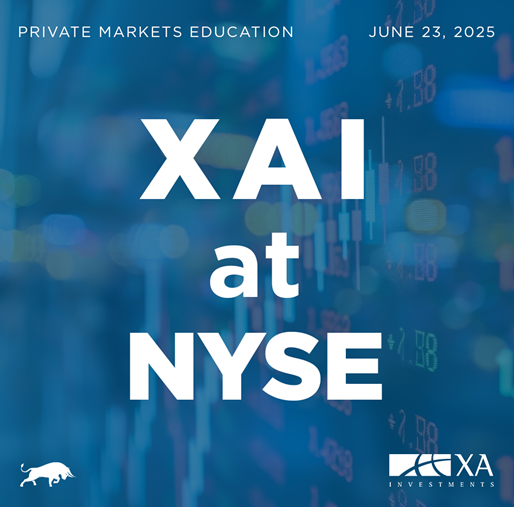 07/03/2025 XAI Private Markets Education Day at NYSE
07/03/2025 XAI Private Markets Education Day at NYSE 06/16/2024 Insights on Alternative Assets with Kimberly Flynn
06/16/2024 Insights on Alternative Assets with Kimberly Flynn 04/30/2024 Insights on Interval and Tender Offer Funds with Kimberly Flynn
04/30/2024 Insights on Interval and Tender Offer Funds with Kimberly Flynn 03/14/2024 Kimberly Flynn and John Cole Scott on Interval Funds and BDCs
03/14/2024 Kimberly Flynn and John Cole Scott on Interval Funds and BDCs 12/14/2023 Insights on Interval Funds and Alternative Assets with Kimberly Flynn
12/14/2023 Insights on Interval Funds and Alternative Assets with Kimberly Flynn-
 08/21/2023
Sustainable Investments: New Markets and
Structures for Raising Capital
08/21/2023
Sustainable Investments: New Markets and
Structures for Raising Capital
-
 05/31/2023
Launching an Interval Fund Through a
Private-Label Provider Can Save Time and Drive Efficiencies
05/31/2023
Launching an Interval Fund Through a
Private-Label Provider Can Save Time and Drive Efficiencies
-
 05/03/2023
The Rise of Alternatives and the New 60/40
Portfolio
05/03/2023
The Rise of Alternatives and the New 60/40
Portfolio
-
 03/22/2023
Interval Fund Governance Considerations
03/22/2023
Interval Fund Governance Considerations
-
 03/08/2023
Career Insights with Helen Vaughan
03/08/2023
Career Insights with Helen Vaughan
-
 02/06/2023
10 Lessons Learned in Launching Interval and
Tender Offer Funds (Non-listed CEFs)
02/06/2023
10 Lessons Learned in Launching Interval and
Tender Offer Funds (Non-listed CEFs)
-
 03/08/2022
Career Insights with Anne Kritzmire
03/08/2022
Career Insights with Anne Kritzmire
-
 12/15/2021
Overcoming the Interval Fund "Valley of
Death"
12/15/2021
Overcoming the Interval Fund "Valley of
Death"
-
 11/29/2021
Permanent Capital Vehicles: Diversify Revenue
Streams and Benefit from Demand Growth
11/29/2021
Permanent Capital Vehicles: Diversify Revenue
Streams and Benefit from Demand Growth
-
 03/08/2021
Career Insights with Danielle Cupps
03/08/2021
Career Insights with Danielle Cupps
-
 01/15/2020
Income and Volatility: Paid to Ride Out a
Storm
01/15/2020
Income and Volatility: Paid to Ride Out a
Storm
-
 10/01/2019
An ALTERNATIVE Approach to Retirement
Planning
10/01/2019
An ALTERNATIVE Approach to Retirement
Planning
-
 07/08/2019
What Are Non-Listed CEFs?
07/08/2019
What Are Non-Listed CEFs?
-
 07/01/2019
Alternative Access: The Old and the New
07/01/2019
Alternative Access: The Old and the New
-
 06/24/2019
How Much Liquidity Do Investors Need?
06/24/2019
How Much Liquidity Do Investors Need?

